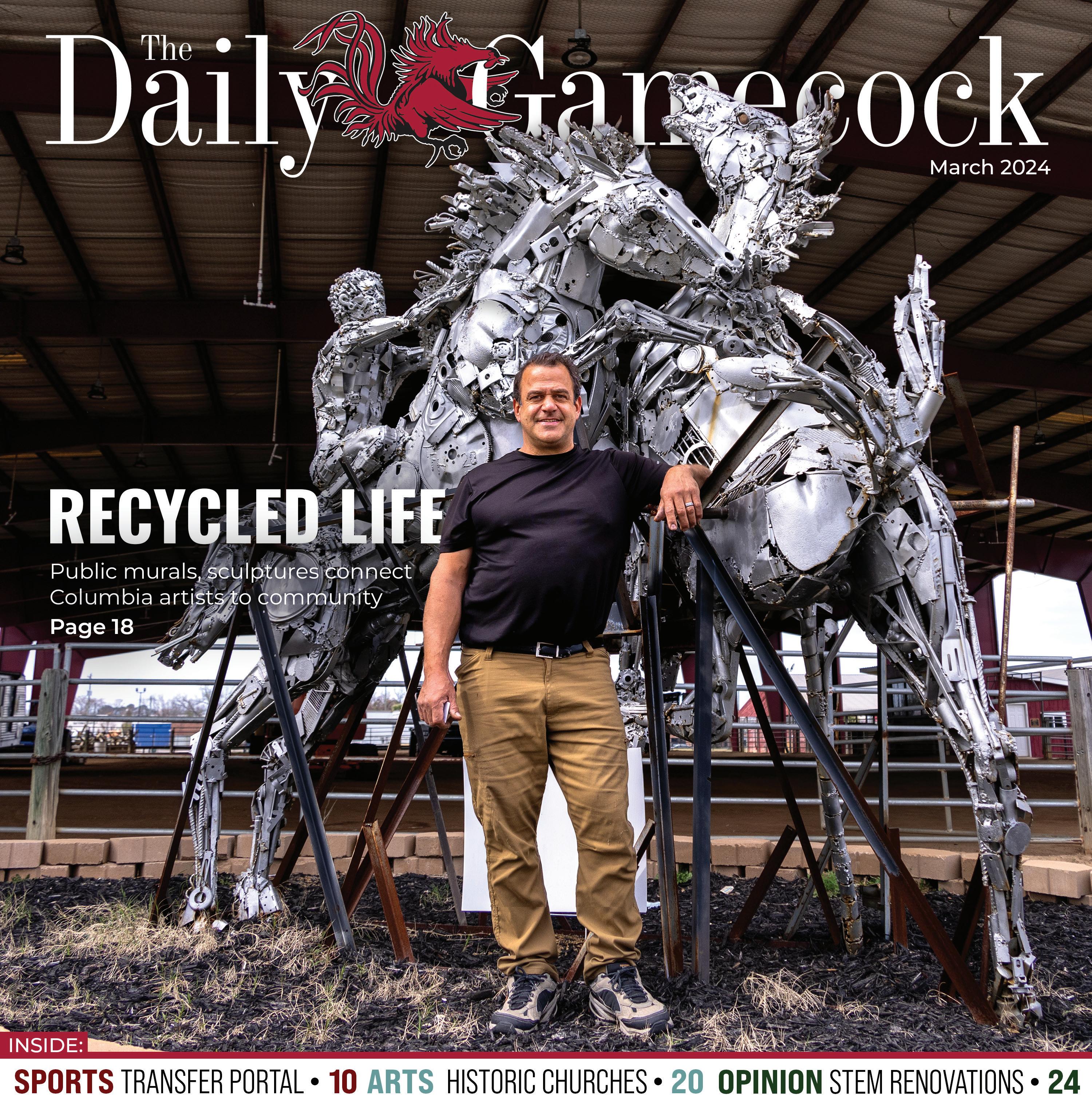




Go to dailygamecock.com/subscribe
03 STUDENT GOVERNMENT ELECTIONS
Find out who will be the next student body president, vice president, speaker of the student senate and treasurer.
05 BAN ON GENDER-AFFIRMING CARE
Advocacy groups push back against a bill that could prevent minors from seeking hormone replacement therapy.
07 SPECIAL OLYMPICS COLLEGE CLUB
Organization hopes to form connections between USC students and people with disabilities by hosting sporting events.
06 TRANSFER CREDITS
The university begins accepting class credit from the 16 techincal colleges in South Carolina.
08 GRUBHUB ROBOTS
USC begins new service that uses machines to deliver food across campus.

10 WOMEN’S TRANSFER PORTAL
Women’s soccer and softball coaches share how NIL and students changing schools have affected the sport.
13 CLUB SOFTBALL STANDOUT
Pitcher Mary Esterak finds home in South Carolina after multiple transfers.
15 USC ALUMNAE IN SPORTS MEDIA
Reporter Alyssa Lang, photographer Tori Richman and more share what it means to see women succeed in their fields.
16 GROWTH IN 2ND SEASON
Women’s basketball forward Ashlyn Watkins steps up in her sophomore season with the Gamecocks.
17 HAIR DISCRIMINATION RESEARCH

18 BRIDGING ART AND THE COMMUNITY
Columbia’s public artists share how their work has helped them forge a bond with locals.

20 COLUMBIA’S HISTORIC CHURCHES
Relgious buildings throughout the city see continuous growth, but stay rooted in their history.
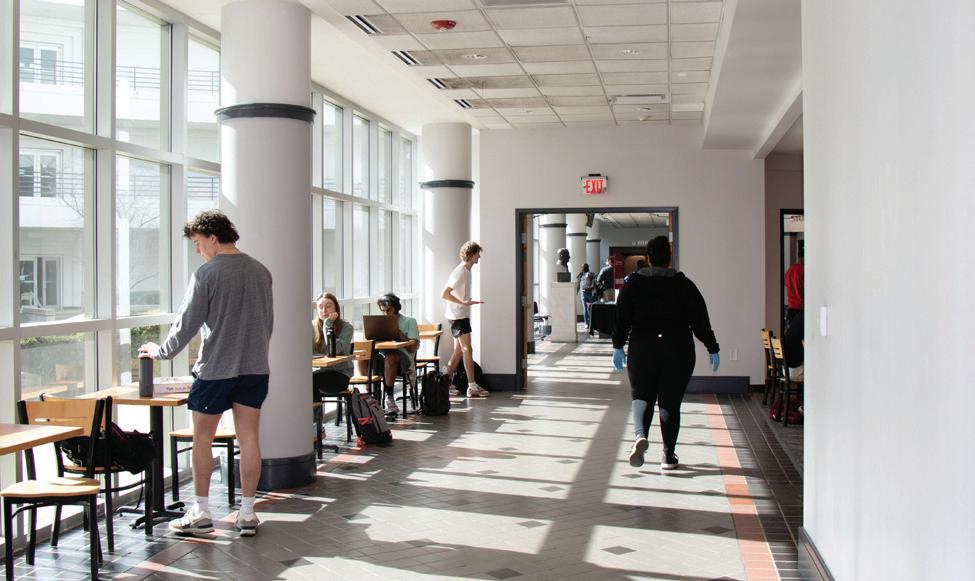
23 CAMPAIGN CRISIS
USC team conducts surveys to better understand how hair discrimination can affect Black men and their mental health. COVER DESIGN
Student Government
24 STEM BUILDING RENOVATIONS
USC has plans that could potentially change the student union. But it should be more focused on updating other buildings first.
26 GREEK VILLAGE EXPANSION
Building more houses in Greek Village will help grow the Fraternity and Sorority Life community.

28 ON-CAMPUS FOOD COSTS
USC needs more affordable options when it comes to healthy meals.
30 MARCH MADNESS PREDICTIONS
Two of The Daily Gamecock’s sports editors speculate South Carolina basketball’s fate in the NCAA tournament.
30 POST SPRING BREAK
Comic portrays what it is like for students to come back to classes after spending a week in the sun.
MARCH 2024 NEWS MAGAZINE
TABLE OF CONTENTS
will not be able to deliver on its promises made to students.
Anna
COVER
Alicia Caracciolo
BY:
Ottinger
PHOTO BY:
UPCOMING CAREER CENTER EVENTS
Workshops & Opportunities for All Students
March
11 Interviewing: How to Prepare to Make a Great Impression
4:05 p.m. | Career Center Classroom
12 Developing a Gameplan to Increase Your Chances of Securing a Job or Internship
4:30 p.m. | Career Center Classroom
18 Teach for America: Free Headshot Event
11 a.m. | Flinn Hall
Pre-All Major Fair Employer Tabling
12 p.m. | College of Arts & Sciences
Service/Gap Year Organizations (City Year, Peace Corps)
12 p.m. | Gambrell
About Play (Psychology/Social Work)
12 p.m. | Barnwell
Networking for Your First Job in partnership with Leadership & Service Center
5:30 p.m. | Russell House Room 205
19 Pathways to Professions: The Federal Government
5 p.m. | Thomas Cooper Library, Room 532
21 Interviewing: Answering Some of the Most Common Questions
4:05 p.m. | Career Center Classroom
22 Richter Mini-Grant & Scholarship Deadline
5 p.m. | https://bit.ly/RichterApp
25 LinkedIn: Network Like a Pro
5 p.m. | Career Center Classroom
25 SC State Agency Industry Day in partnership with College of Arts & Sciences
1:30 p.m. | Russell House Ballroom
April
17 Spring 2024 Grad Bash
12 p.m. | Greene St. in front of Russell House
June
14 South Carolina Internship Program Application Deadline for Summer 2024
https://bit.ly/SCInternshipProgram
Career & Internship Fairs
March
19 All Majors Career & Internship Fair, Day 1 11 a.m. | Russell House Ballroom
20 All Majors Career & Internship Fair, Day 2 11 a.m. | Russell House Ballroom
21 Virtual All Majors Career & Internship Fair 10 a.m. | Virtual via Handshake
Pre-Professional Workshops
March
19 Writing for Your Medical School Application
7 p.m. | Virtual
21 Writing for Your Medical School Application
6 p.m. | Virtual
26 Writing for Your Physician Assistant Application
7 p.m. | Virtual
April
9 Medical School Application: Next Steps
7 p.m. | Virtual
11 Medical School Application: Next Steps
6 p.m. | Virtual
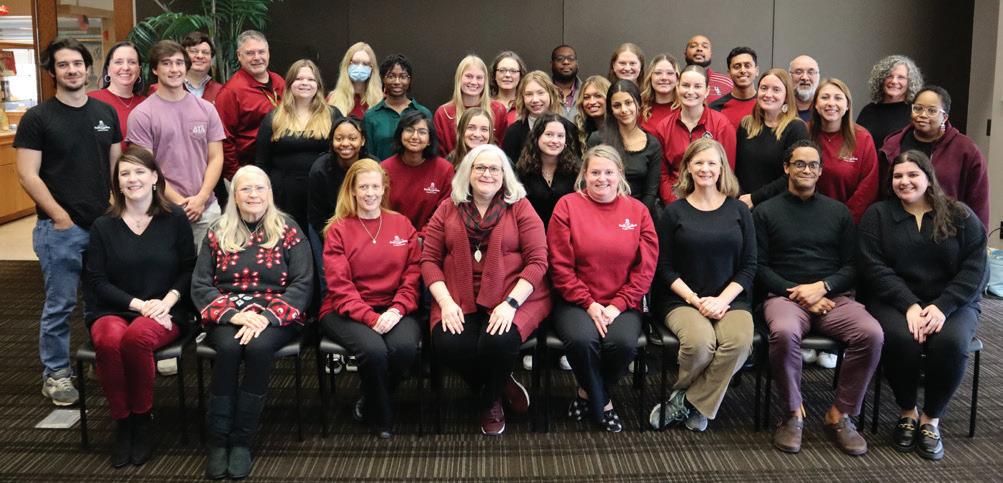
OR VISIT ONE OF OUR FOUR LOCATIONS University Career Center (Thomas Cooper Library, Level 5) College of Engineering & Computing (Swearingen, 1A03) Graduate Student Resources Hub (Close-Hipp, 204) Pre-Professional & Graduate School Advising (Sumwalt, 208) CONNECT WITH US ONLINE sc.edu/career facebook.com/UofSCcareers instagram.com/uofsccareers 803.777.7280
Be Career Ready! To Get There — Start Here. OUR STUDENT & PROFESSIONAL STAFF ARE HERE TO HELP YOU SUCCEED! Make an appointment with your Career Coach today! To register for these and other events, visit the events page on sc.joinhandshake.com

Patton Byars will become the next student body president
MARLEY BASSETT | assistant news editor
Patton Byars will become USC’s next student body president, the elections commissioner announced on Feb. 21.
The other Student Government executives elected were Courtney Tkacs for vice president, Maura Hamilton for speaker of the student senate and Jacob Vaught for treasurer. All candidates ran unopposed for 2024.
Byars, who has served as chief of staff for former Student Body President Reedy Newton and current Student Body President Emmie Thompson, ran a campaign aimed at fixing common issues faced by students at USC including infrastructure, safety, student experience and Wi-Fi.
Byars said he is ready to hit the ground running once he assumes
his role in late March, working to accomplish his campaign promises.
“(On) March 20, I pledge, I will be meeting with (the incoming vice president for information technology), and we’re going to be talking about Wi-Fi on our campus,” Byars said.
Tkacs, who serves as chief of staff to Speaker of the student senate Cameron Eubanks, ran on a joint ticket with Byars. A large part of her platform focused on addressing housing issues for upperclassmen, who are struggling to find on-campus accommodations after their first year.
Tkacs said she is eager to start forming relationships with members of the campus community so she will be better suited to represent them.
“I can’t wait to meet all of the faculty and administration and build relationships with them to be able to fix problems,” Tkacs said.
Hamilton, who is a senator for the College of Nursing and chairwoman of the senate judiciary committee, ran on four key pillars, including “for the Gamecock campus,” “for the Gamecock citizen,” “for the Gamecock classroom” and “for you.” A key point of Hamilton’s platform is increasing senators’ outreach to their student constituents.
Hamilton said she hopes to start working on outreach to recruit more student senators for the next senate term.
“I want to work on filling some of our vacant senate seats. My goal by the end of the year is to fill all 50
spots, and hopefully that will be possible,” Hamilton said.
Vaught, who is the chair of the ad hoc committee for finance reform, ran a campaign that centered on implementing the new finance reforms. Vaught also wants to make Student Government funds more equitable for all student organizations.
Vaught was not present at the results announcement and was therefore unavailable for comment.
Only nine of the 45 senators in student senate returned. The rest did not run again.
The newly elected members will be inaugurated on March 20, in Rutledge Chapel from 4 to 5:30 p.m.
 PHOTO: NICKOLAS HILL
Student Body President-elect Patton Byars and Vice President-elect Courtney Tkacs pose for a photo with their team following the announcement of the Student Government election results on Feb. 21, 2024. Tkacs and Byars campaigned together as running mates for the election.
PHOTO: NICKOLAS HILL
Student Body President-elect Patton Byars and Vice President-elect Courtney Tkacs pose for a photo with their team following the announcement of the Student Government election results on Feb. 21, 2024. Tkacs and Byars campaigned together as running mates for the election.




800 Alexander Road | (803) 772-2200 Secure your home at Alight today. Scan to learn more MEMORIES BEGIN WHEN YOU MOVE IN
Advocacy groups speak out against bill that would ban genderaffirming care for minors: ‘They’re seeing their rights on trial’
GRAY QUIRE | news writer
The South Carolina House of Representatives’ Medical, Military, Public and Municipal Affairs Committee introduced a bill in early January that intends to ban gender-affirming care for minors, sparking outrage from activist groups across the state.
Bill H. 4624, dubbed the “Help Not Harm Bill,” would prevent anyone under the age of 18 from accessing healthcare methods to assist them in transitioning from their gender assigned at birth, such as hormone replacement therapy and gender reassignment surgery.
The bill would also prevent adults up to 26 from using South Carolina Medicaid Program funds to cover gender-affirming care, and it would force school officials to inform parents if their child is questioning their identity.
The bill passed in the House by a vote of 82-23 on Jan 17. Since then, it has been introduced in the Senate and referred to the Medical Affairs Committee, which has yet to set a date to review it.
Chase Glenn, the executive director of the Alliance for Full Acceptance, said the organization will do
everything in its power to stop the bill from becoming law.
“I have to believe that we’re going to stop this bill,” Glenn said. “Because we believe that there will be grave consequences if this bill passes — that trans people’s lives are on the line.”
Lacey Layne, an elementary public school counselor in Fort Mill, testified during the committee meeting about the dangers of forced outings.
“As a school counselor, I’m aware that outing a student to their family can put them at risk for harm,” Layne said. “Trans students are much more likely to be abused by their immediate family based on their gender identity. Familial rejection and abuse dramatically increase the risk of suicidality, substance abuse and depression.”
Rep. John R. McCravy (R-Greenwood) reviewed the bill before the committee and said passing this legislation is one of the most important things the legislature can do.
“There are few things we do as legislators that are more important than protecting vulnerable children,” McCravy said. “One of those important legislative


protections that has come to pass is to protect minors from so-called gender transition procedures.”
Glenn said the bill is nothing but political posturing to get votes.
“This bill is unfortunately using trans kids as political pawns,” Glenn said. “These legislators that filed this bill, they know full well that this is purely a political game.”
The bill is not the first anti-trans legislation to be recently proposed in South Carolina.
In March 2023, Bill S. 0623 aimed to prevent anyone more than a year old from changing the gender on their birth certificate. But there is an exception if someone does not have a birth certificate. They can file a petition to include “gender changes.”
The Help Not Harm bill passed in the House despite heavy opposition from almost all who testified before the committee. Of the 48 people who testified, only one spoke in favor of the bill.
Matt Sharp, who serves as senior counsel for Alliance Defending Freedom, an organization that has defended anti-LGBTQIA+ legislation across the country, supported the bill. Sharp said the Help Not Harm bill is about protecting children from peer pressure on social media.
“This bill protects children who deserve to experience a natural childhood, who are highly susceptible
to peer pressure, social media and other negative influences,” Sharp said.
Phillip Ford, the founder of the Ford & Ford group, a South Carolina advocacy group, testified to the committee and opposed the bill.
“According to the Trevor Project, 94% of LGBTQ+ youth will report having negative mental health impacts,” Ford said. “They’re watching, and they’re listening. They’re seeing their rights on trial.”
Glenn said he considers this bill to be “bullying youth” and that it is “looking to solve a problem that doesn’t even really exist within our state.”
“It’s hard for me to fight this bill, because there’s so much misinformation and misconstruing of actual fact in the arguments these legislators make,” Glenn said. “It’s difficult to combat that.”
Tate Few, a first-year USC law student, was one of 47 who opposed the bill in front of the committee. He testified for transgender children in South Carolina who would be affected by the Help Not Harm Bill.
“This is going to cause subsequent mental health issues,” Few said. “It’s going to cause depression and suicide for transgender youth and for those that are transgender up to the age of 26.”
The Help Not Harm bill still needs approval from the Senate before passing. It was introduced on Jan. 18 in the Senate and referred to the Medical Affairs Committee. The date on which the committee will review the bill is undetermined.
FILE - The south entrance of the South Carolina Statehouse on Jan. 17, 2022. The S.C. House of Representatives approved a bill that could prevent minors from obtaining gender-affirming care.
Phillip Ford of the Ford & Ford Group speaks in front of the House Medical, Military, Public and Municipal Affairs Committee at the S.C. Statehouse on Jan. 17, 2024.
PHOTO: xavier martin
PHOTO: GRAY QUIRE
USC grants class credit to technical college transfer students
mckayla walcott | news writer
USC announced in January that it has entered an agreement alongside Clemson University with the SC Technical College System to grant 30 hours of core course credit to students who transfer from the 16 technical colleges in the state.
The Statewide Transfer Partnership Agreement was finalized six months after the state legislature urged its schools to find ways to alleviate the cost of pursuing higher education, said Tim Hardee, the president of the SC Technical College System.
“If we can have this transfer agreement to help students graduate early, then in my mind, it also means they have less student debt,” Hardee said.
When technical college students transferred to universities in the past, they often faced the possibility of losing some of their course credits and having to retake these courses, Hardee said.
The agreement guarantees that 30 credit hours — equal to about one year of classes — will be granted by USC and Clemson to ensure that transfer students do not lose credit for the core classes they completed at their technical college. Not losing credits in the transfer process makes earning a bachelor’s degree from USC or Clemson more affordable, Hardee said.
The reason behind the 30-hour threshold is that students have usually met most of their general education requirements within that time period, he said.
The agreement aims to provide pathways for students who choose to complete their first year at a technical college, Hardee said.
“You have some students that may not be ready for that transition from high school to all of the demands of entering as a freshman at USC or Clemson,” Hardee said. “For some
students, taking that first year enables them to be better prepared maturity-wise and academically to be able to then be successful.”
Hardee said the agreement does not affect the specific courses required by different major programs. It only applies to general education courses.
It is possible for a student to receive more than 30 credit hours from a technical college, but it depends on the university’s specific rules, Hardee said.
The agreement also has a reverse transfer option in which the university will send the transfer student’s transcript back to the technical college to show that they fulfilled the requirements for an associate degree. This allows the student to opt for an associate degree from the technical college if they so choose.
Kallsen Wright, a second-year international business applicant and transfer student from Tri-County Technical College, said the reverse transfer option
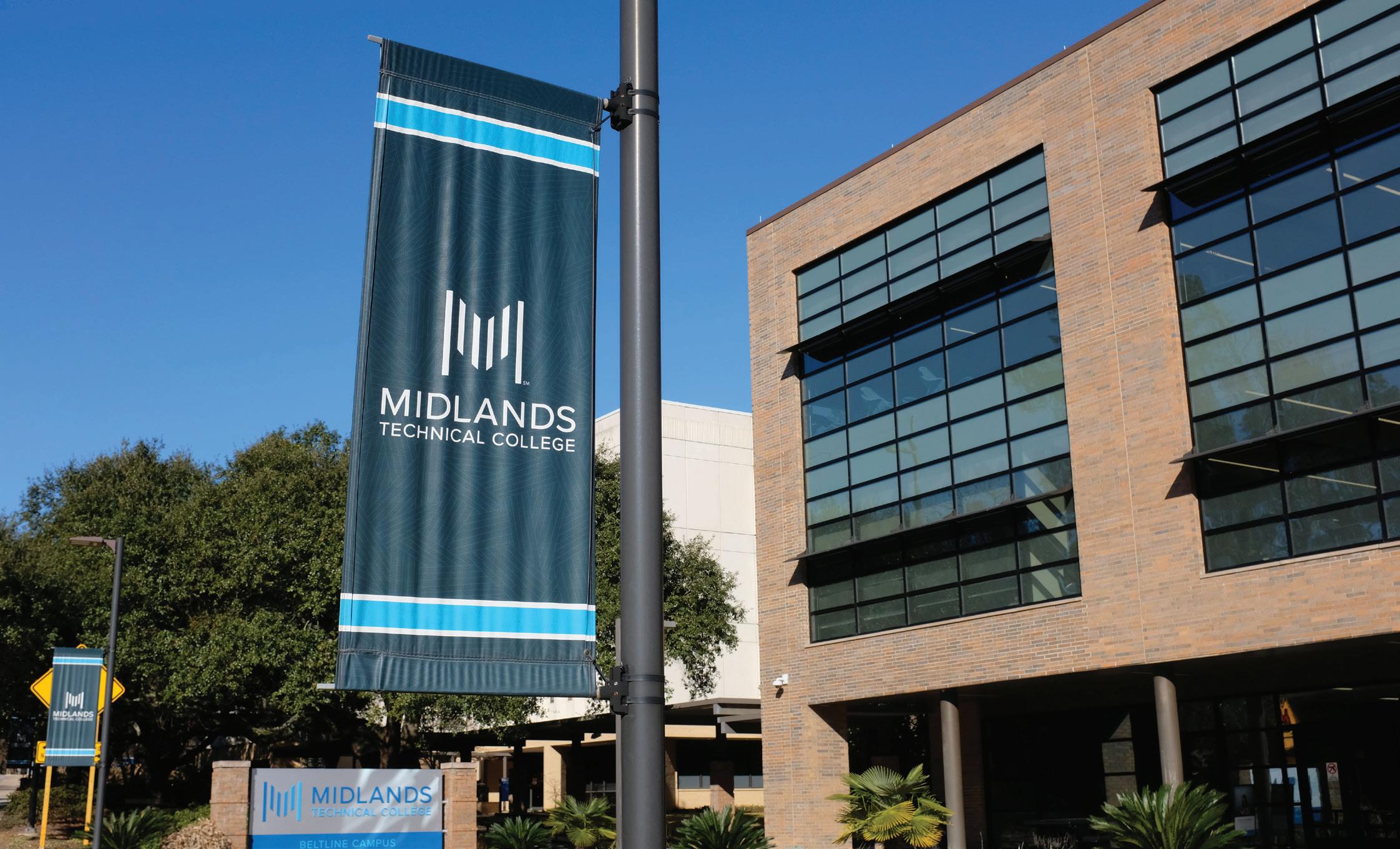
will make future transfer students feel more secure at the university.
“If something happens, it’s not the end of the world. If money falls through, they can still get the degree, and so they’re not going to be spending nights trying to figure out, ‘How can I earn money to pay for this?’” Wright said. “But then, I can still drop down to a (technical college) and be successful. I don’t have to be here to make it work. It’s just about my own abilities.”
Wright also said the partnership is important for students who may not be able to pay for four years at a university.
“(The agreement) sets (students) up to be able to still get education and learn and not be held back by something they couldn’t control growing up,” Wright said. “Lots of businesses today want a college degree, whether associate or bachelor’s, and (students not being) held back by financial things is so big. We know a lot of people who just want to do it, but they’re not financially capable, so this is a big step to let them continue to pursue their dreams.”
Seth Hughes, a third-year public health student who completed dual enrollment courses at Central Carolina Technical College during high school, said the agreement is beneficial because it gives students of all financial backgrounds the opportunity to attend a large institution.
“Poor communities might not be able to send their students, especially if they’d be the first generation interested in schooling,” Hughes said. “I don’t think there’s necessarily a downside as long as you’re pro-education.”
USC and Clemson were the main targets of the new agreement because they are the largest institutions in the state, but Hardee said it will hopefully apply to other South Carolina schools in the future.
Hardee said his role as president of the state’s technical college system is to provide a highly qualified workforce. Part of doing that is by having more graduates, whether it be from a technical college or a university.
“Different students have different career paths. And what we’re trying to do is, as a state, we can’t afford to have people on the sidelines. We need highly skilled individuals to meet the demands of the workforce of tomorrow,” Hardee said. “Another way for us to do that is making it more affordable.”
The Midlands Technical College - Beltline Campus banner stands attached to a light pole off Rosewood Drive on Feb. 6, 2024. The University of South Carolina will now grant 30 hours of core course credit to transfer students from one of the state’s 16 technical colleges.
PHOTO: julia spies
Special Olympics student organization aims to create more opportunity in sports for people with disabilities
Carrigan woodson | STUDENT GOVERNMENT BEAT WRITER
The Special Olympics is the world’s foremost sports organization for children and adults with intellectual disabilities. USC is set to join this legacy with its first Special Olympics club.
The Special Olympics College Club connects college students with fellow community members who have intellectual disabilities. The club aims to enhance participants’ lives through engaging in sports, participating in community service and supporting social justice initiatives aligned with Special Olympics. Participants must be 18 years old or older to participate, and there is no maximum age requirement.
Second-year graduate public administration student Keaton Bentley is the president of the Special Olympics College Club at USC. He said the club hosts a variety of events so that members can enjoy different activities and interests.

Garnet Gate. The whole student body is encouraged to participate, he said.

“The essence of this club is just pure happiness,” Bentley said. “If you’re looking for an event where you can be involved, meet new friends and walk out of there knowing that you made a difference in someone’s life, this is our club.”
Kayla Adler, a third-year exercise science student, joined USC’s Special Olympics club to look at forming a gymnastics team. She said the club is hoping to educate people about working alongside people with disabilities.



“Our unified events are primarily through sports, so things like maybe basketball or flag football or soccer, but we also are going to host events, such as movie nights, social hangouts and parties, to make sure we’re
gauging everyone that has interest,” Bentley said.
After starting a Special Olympics student organization at Colorado State University as an undergraduate, Bentley said he knew he wanted to start one at USC.


“We’re hoping that, long term, people with and without disabilities from the surrounding Columbia area will know who we are and feel comfortable and look forward to coming to our events,” Bentley said. “Just creating one big, new family.”
The Special Olympics College Club has partnered with South Carolina’s Special Olympics organization as well as the Fellowship of Christian Athletes. Bentley said these groups have been instrumental in making the USC organization a reality.
The Special Olympics College Club is aiming for rapid growth, but Bentley said the staff is approaching it one step at a time by hosting tabling events during organization fairs and creating a profile on
“I think that there’s not a huge club representation of the unified community,” Adler said. “I think that one of the biggest things that we’re hoping to see is just increased awareness and also increased training for — we have a ton of pre-health students that want to go into healthcare and working with people with disabilities and things like that. And so training people how to comfortably handle situations is huge.”
Travis Luthren, a Special Olympics athlete and program associate at Special Olympics South Carolina, said he believes joining USC’s Special Olympics club can help students with disabilities become more involved in the college experience.
“Keaton has the experience of the college lifestyle, and for me, I was born with Down Syndrome,” Luthren said. “I thought it would be a great opportunity for people with intellectual disabilities to have a life here at USC.”
Luthren said all students who have disabilities and special needs could benefit from joining the club because it opens up many doors for them and allows for growth in a variety of areas.
“(This club) helps with all my dear friends to have the opportunity to do what they do in sports,” Luthren said. “It helps them to give back in the community. It helps to teach them public speaking skills. It helps them to go out there, meet people. It helps
 Illustration: anna ottinger
Illustration: anna ottinger
USC launches autonomous Grubhub food delivery robots
COlin Elam | News Writer
Autonomous food delivery robots launched at the University of South Carolina in early February, serving students food in the main campus area from 11 different on-campus dining locations.
The university first announced the full launch in a press release on Feb. 1. The robots can deliver to multiple locations on campus between Assembly, Blossom and Gervais streets, according to the press release.
The new delivery service is the result of a partnership between USC, Grubhub and Starship Technologies, the manufacturer of the robots. This is the first introduction of Starship’s technology in the state.
“We’re the first in South Carolina to do this,” university President
Michael Amiridis said. “(We’re) very proud of that.”
The university is already planning to expand the area of service on campus and increase its fleet of robots up to 60 units to reflect student demand, said Joe Fortune, the director of revenue contract management and support at USC.
“We’re averaging about 80 to 90 deliveries per day right now,” Fortune said. “And so after today, we expect that number to increase as people learn more about how to make that order on their phone and through the app.”
Fortune said the discussions between the university and Starship Technologies that led to the project began last April after the university gauged student
needs and desires as part of a strategic planning process.
Student feedback showed demand for an easier and more accessible way to acquire campus dining options, said Faren Alston, the marketing manager of Carolina Food Co.
Alston said the addition of the delivery robots on campus centers around enhancing the student experience.
“It’s a huge campus, and sometimes (students) feel like they don’t have full accessibility to food on campus,” Alston said. “From an accessibility standpoint, a convenience standpoint, we hope that these robots will fulfill what our students are looking for.”
Both Starship Technologies and Carolina Food Co. are hiring students to

help run the delivery service. Starship Technologies is recruiting students with backgrounds and interests in technology, Alston said. These student employees will work on putting the robots in and out of service each day and performing necessary maintenance on them, such as replacing components prone to wear and tear and ensuring that the robots are fully charged, she said.
“(We are) in the process of hiring a team of students to actually kind of let them out in the morning,” Alston said. “They would go over to the science and tech building, roll them out. You scan a QR code to put them in service, and then from that point, they’re free to just go to their dedicated locations.”
The robots travel using machine learning technology, artificial intelligence and sensors that enable them to map out the surrounding area to the nearest inch. They are able to cross the street, climb curbs and travel during the night — even through rain or snow.
But human operators are able to assume control of the robots if they need to be moved outside of their programmed routes or if their self-driving system is interrupted by obstacles.
The robots have separate, insulated compartments to maintain the temperature of food and drink during transport.
Customers can use the Grubhub app to select a restaurant from a list of locations within the main campus to order from. Payment methods include CarolinaCash, meal plan dollars and debit or credit cards, but meal plan swipes are not an option. Robot delivery carries an added fee of $3.49.
Users can then track the robot as it travels to their location. Upon arrival, users will receive an alert and be able to unlock the robot with the app.
Fortune said he anticipates that the robots will be a valuable addition to campus and continue to enhance student experience in the future.
“Obviously, this spring is a limited launch, but we hope to expand the fleet in the future and expect nothing but good things,” Fortune said.
NEWS 8
PHOTO: Emma Wyatt
University of South Carolina Grubhub robots sit stationed outside of the McBryde dorms on Feb. 25, 2024. The university hopes to increase the amount of Grubhub robots to 60 in order to meet student demand.


Visit us at stationatfivepoints.com Give us a call 803-937-4579 THE STATION AT FIVE POINTS When you choose Station at Five Points to call home, student living gets easier. No matter what your day looks like, you'll come home to comfort, convenience, and service of a team dedicated to you. ELEVATE YOUR WAY OF LIFE Now leasing for 2024-2025

South Carolina women’s sports face annual turnover on rosters due to NIL, use transfer portal to help with depth
will kelly | Assistant Sports Editor
The world of college athletics has undergone major changes in recent years. From conference realignment to ever-expanding playoff systems, there is one change that has stuck out from the rest: the transfer portal.
The NCAA transfer portal was established in 2018 as an easier way for
college sports by allowing student-athletes to continue their education when there may not be a professional league they can join.
Head softball coach Beverly Smith said the presence of the transfer portal is a “new landscape,” in the greater realm of college athletics. Despite its recency,
Smith added five new players via the portal over the summer and winter breaks of 2023,
Those players are senior infielder Denver Bryant from Auburn, fifth-year pitcher Alana Vawter from Stanford, redshirt junior outfielder Bre Warren from Texas A&M, redshirt senior utility player Kianna Jones
leaving and arriving from the portal, she said. The transfer portal is particularly useful, Smith said, when she has to account for injuries that could potentially impact her team during the season.
“If you have an injury — Denver Bryant’s a perfect example,” Smith said. “We thought we were going to be really thin in the middle. Denver Bryant was in the portal, and she really has come in and gives us instant depth and experience in the
The only professional softball league in the country is Women’s Professional Fastpitch. It has four teams and a draft that consists
The transfer portal has given many players opportunities to continue their careers after not getting much playing time at previous schools or having to switch schools due to

SPORTS | FEATURE 10
academic reasons, with playing being an added bonus.
Vawter came to the university to pursue a master’s degree after not getting into a graduate program at Stanford at the beginning of 2023.
Vawter said. “I kind of knew that that was what I wanted out of my extra year of eligibility from COVID, and so I knew that there was going to have to be other options.”
innings across 11 games with a 1.86 ERA, 34 strikeouts and six walks.
helped the Gamecocks, as the team has won nine of the 11 games she has pitched in. But Vawter was not the first transfer player to make an impact on the softball team.
26-30 (3-21 SEC) in 2022. It improved to 40-22 (9-15 SEC) in 2023 and almost won the SEC tournament with help from then-junior utility player Aniyah Black from Georgia and then-junior catcher Jen Cummings from Washington.
batting average, 37 hits and 26 RBIs. Cummings finished the year with a .276 batting average, 35 hits and 26 RBIs.
in the 2023 season. Prior to transferring, she had played in 51 total games over the course of two seasons. It was a similar story for Cummings. She played in 61 games in the 2023 season and had only played in 57 over her two years at Washington.
333 Division 1 women’s soccer teams, leading players to enter the portal to maximize their playing time.
But head women’s soccer coach Shelley Smith said some players enter the portal
“It’s just probably made it more difficult for those (incoming freshmen) because rosters are pretty full,” Shelley Smith said. “For us, we have five fifth-year players returning, which is great, but if we keep adding freshmen,
in our conference have been doing,” Jamie Smith said. “For us, it’s more, one or two or three kids here or there, and you’re adding experience and likely filling a hole for a year or two (for) these kids that have that extra
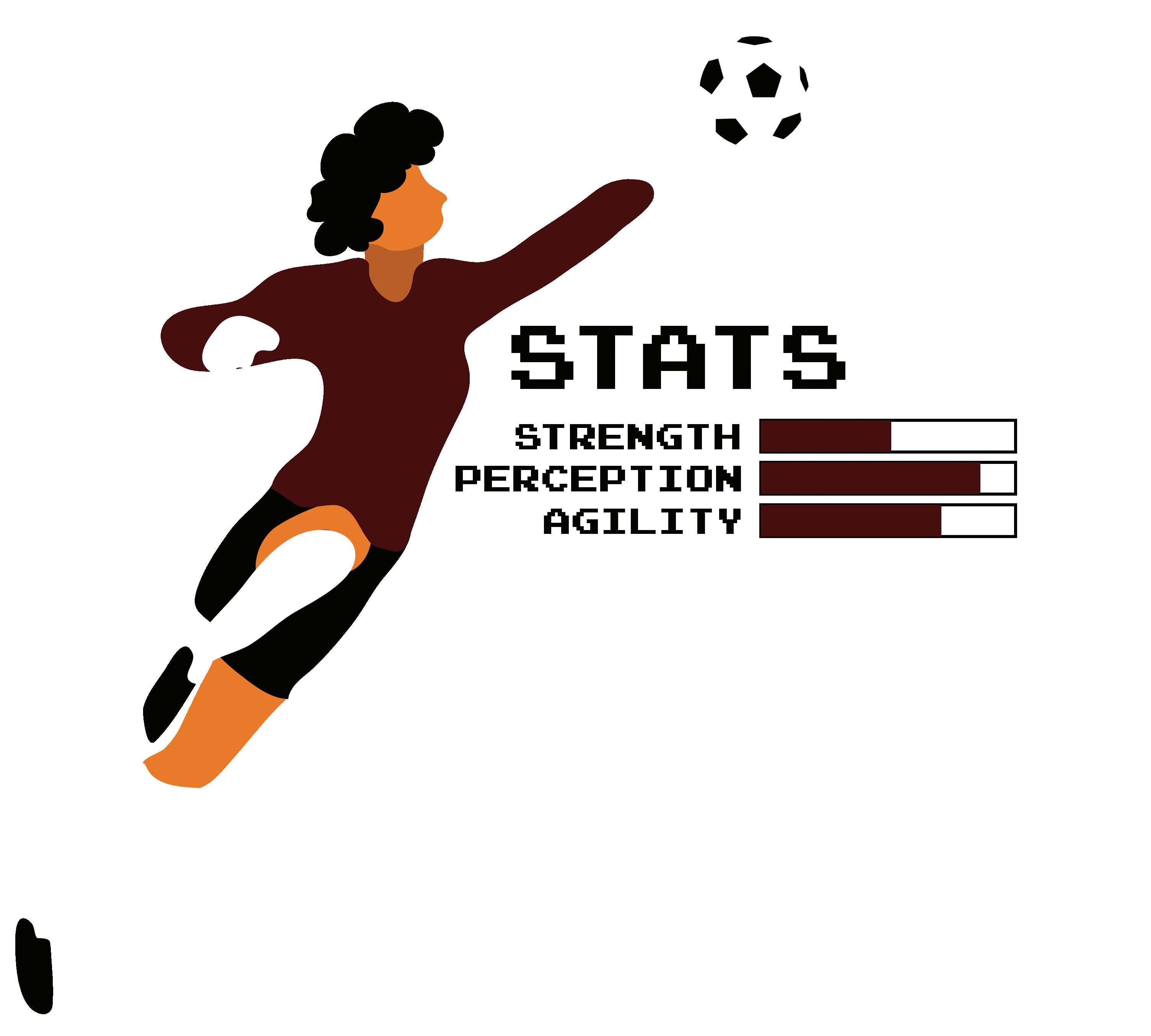
SPORTS 11 Illustration: Callie Hribar
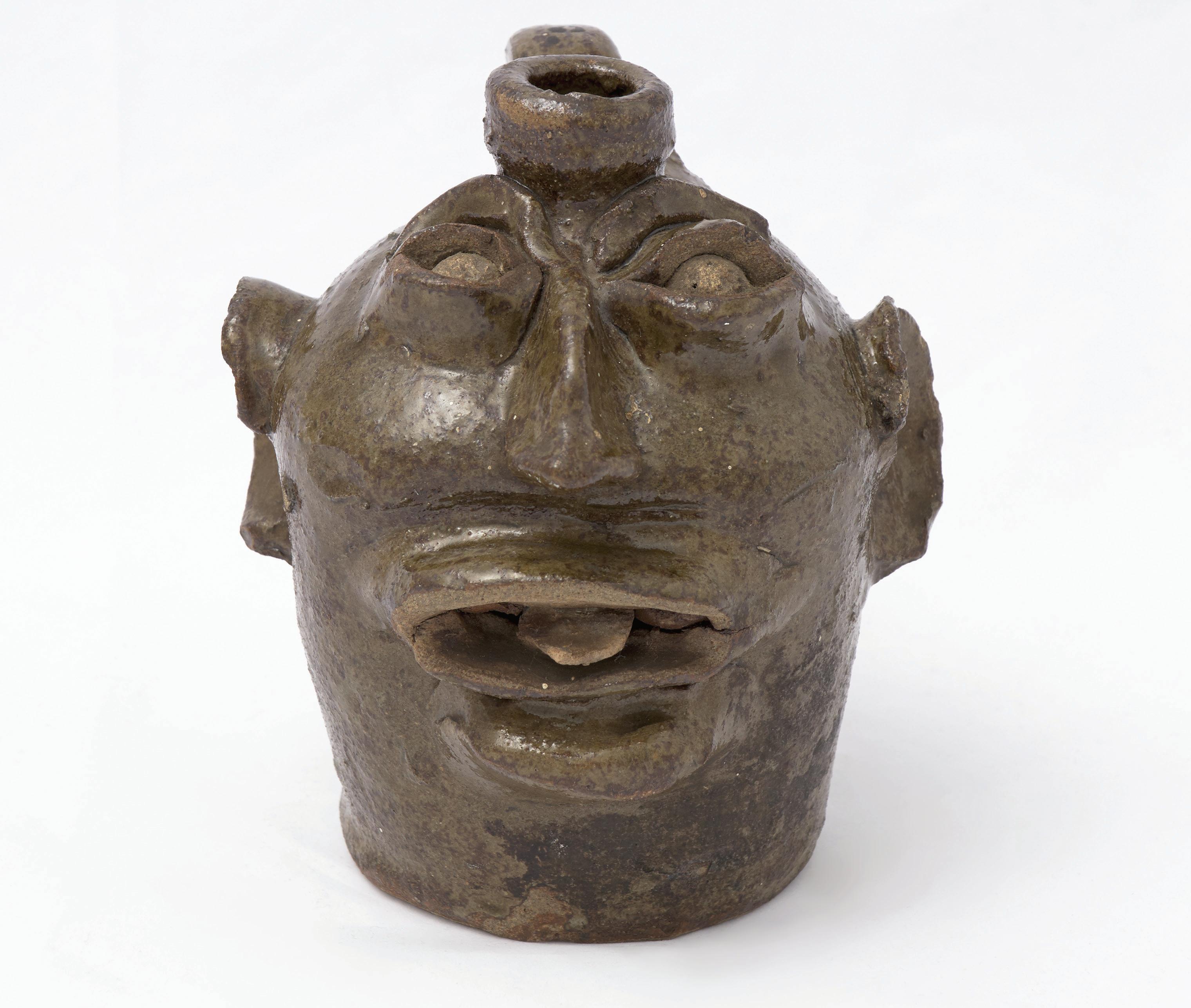
SCMUSEUM.ORG | 301 GERVAIS STREET BE CURIOUS Explore Art, History, Science & More Visit Today Unknown maker. Face Vessel. c. 1855-1865. Alkaline glazed stoneware. Collection of the South Carolina State Museum.
Club softball 2-way player Mary Esterak fosters meaningful connections after transferring colleges
Will Miller | Club Sports Beat Writer
For some college athletes, their chosen school is everything they’ve imagined.
But for others, their first team isn’t always the right match.
Fourth-year art education student and club softball player Mary Esterak transferred twice before she was able to find a place where she felt like she belonged.
Esterak started playing softball when she was 5 years old and spent most of her childhood playing on a travel team. She went on to play for Blue Ridge High School’s softball team in Greer, South Carolina, where she tallied more than 100 strikeouts in two seasons and had a career batting average of .500.
Her on-field efforts led to her signing a letter of intent to play at North Greenville University for the 2021 season. Esterak would play for the Crusaders for just one season before transferring to Columbia International University, where she helped the Rams reach its first NCCAA Softball World Series championship in 2022 while also leading the team with 64 strikeouts.
Esterak dedicated two years to the Rams, but she was once again looking for a change after her junior year.
“I went to one school my freshman year. It just wasn’t the right path for me — nothing that I expected, so I transferred to another school for two seasons,” Esterak said. “It was kind of the same thing, a toxic environment. I just wanted to better myself for my mental health.”
Esterak would be heading to her third school in three seasons, but this did not mean her softball journey was over. Upon arriving at South Carolina in 2023, she discovered the school had a
club softball team that formed in 2021, allowing Esterak and other softball players to continue their careers at the non-competitive level.
“I just decided to hang up the cleats and come to USC, but little did I know that they had a club team here,” Esterak said. “I was like, ‘I guess it’s not over yet.’”
Since joining the team, Esterak has made a difference, both at the plate and on the mound. She leads the team with 14 hits and has a batting average of .389 as of March 3.
Carolina Club Softball is off to an 8-3 start to the season and is tied for first in the South Atlantic Region North Conference. Esterak has struck out 29 batters over 36.1 innings pitched and has an ERA of 1.93.
Esterak had some experience hitting for Columbia International University, but she has been pitching for much longer, she said.
hit. And of course I still play in the field sometimes, but it’s just always my strength is pitching and hitting.”
Even with the success that Esterak has had this season and throughout her softball career, she said there are challenges that come with playing multiple positions, such as staying motivated and managing a heavier workload.
She has family members and coaches who push her to be the best pitcher, hitter and fielder that she can be, she said. But for Esterak, her own selfmotivation is crucial for improving in each of these positions.
“It’s something that I have in my heart that I want to get better, and I want to get better in not just one aspect. And I think that’s just something that a player has to decide for themselves,” Esterak said. “For me, it’s just some days I’m just like, ‘Man, I don’t really feel like getting out of bed today. I’ll just do some drills for pitching.’ But I just have to find ways to motivate myself to do both and give my 100%.”
Esterak has formed strong bonds with her new teammates, including fourth-year elementary education student Gabrielle Kirkman and first-year undeclared student Gracie Carlin.
“It’s just been a sisterhood. Me and Mary nonstop, we go out together, we go to bible study
together — just, we’re together. And this is a friendship that I never thought I would ever form in my life,” Kirkman said. “It’s one of those college friendships that I know I’m going to take with me into life.”
Carlin said the team plans social events, such as group dinners, in order to build close relationships outside of softball.
“(We) try to coordinate parties and dinners,” Carlin said. “We go out, see each other outside of softball, just so we can have more of a relationship outside of softball.”
These off-field connections can be felt on the field as well, as players will celebrate together after big plays and pick each other up when the team is struggling, Esterak said.
Esterak’s impact on the club softball team isn’t just limited to her on-field performance. After assisting an old high school coach with her team, she fell in love with helping young softball players with pitching and hitting drills, she said. Esterak now coaches the Carolina Thunder youth travel softball team.
Esterak said that while she may not have enjoyed the start of her collegiate softball career, she is now enjoying the benefits of having a close-knit and supportive group of teammates.

“I started pitching when I was 8 years old, so I’ve mainly been pitching basically my whole career,” Esterak said. “I’ve mainly just filled out my role the last three, four years now just a pitcher and
“When I came to this club team, everybody loved each other, and everybody wanted to be there.” Esterak said. “I have a team that has my back, so just being able to step out on that field with practices and at games, and even traveling together, has been one of the best memories that I’ve had being in college thus far.”
SPORTS 13
PHOTO: Myles Harris Fourth-year art education student Mary Esterak pitches at Brookland Cayce High School as the Gamecocks compete in a team scrimmage on Jan. 22, 2024. Esterak leads the team with 14 hits and has a batting average of .389 as of March 3.

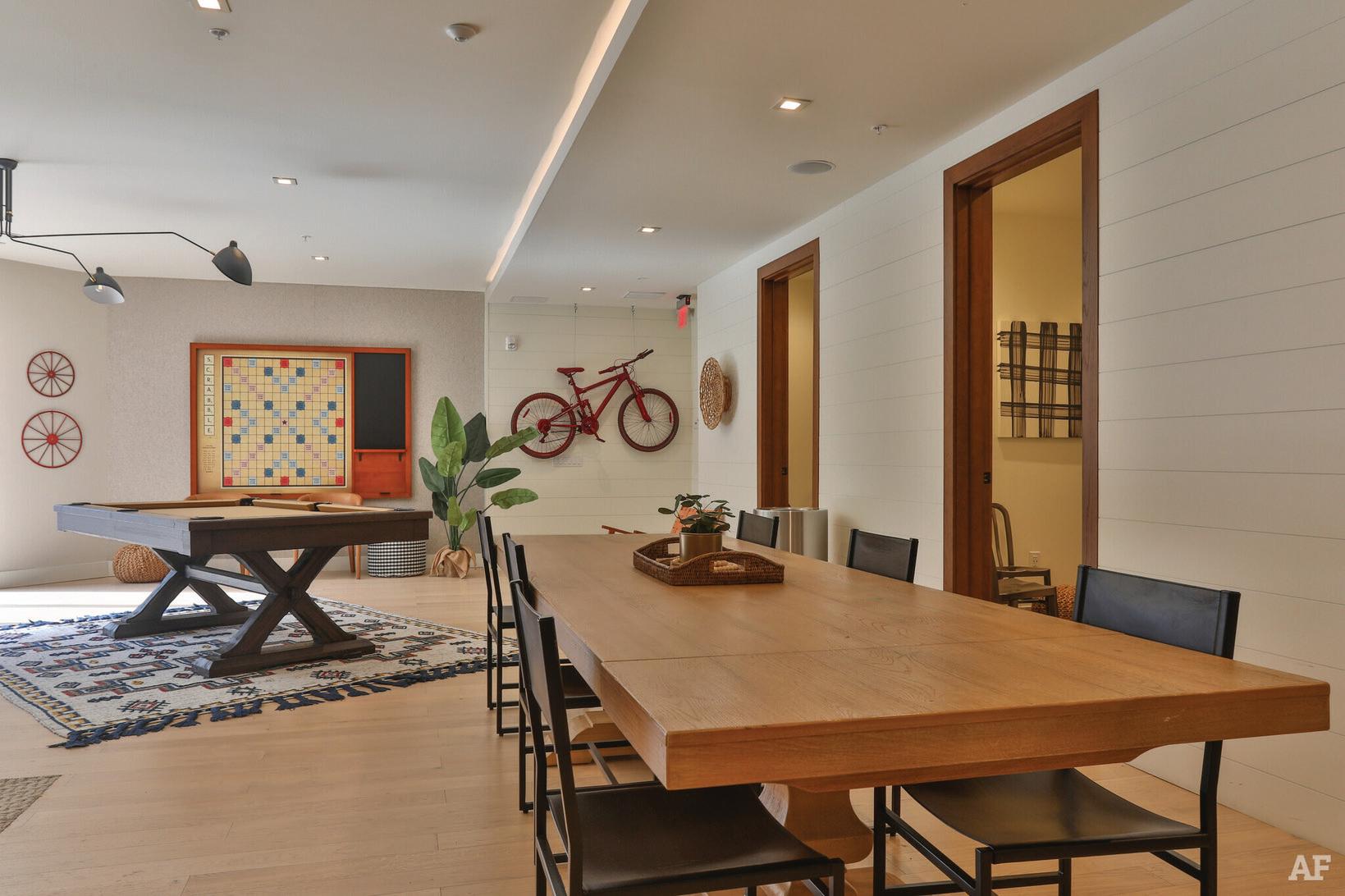



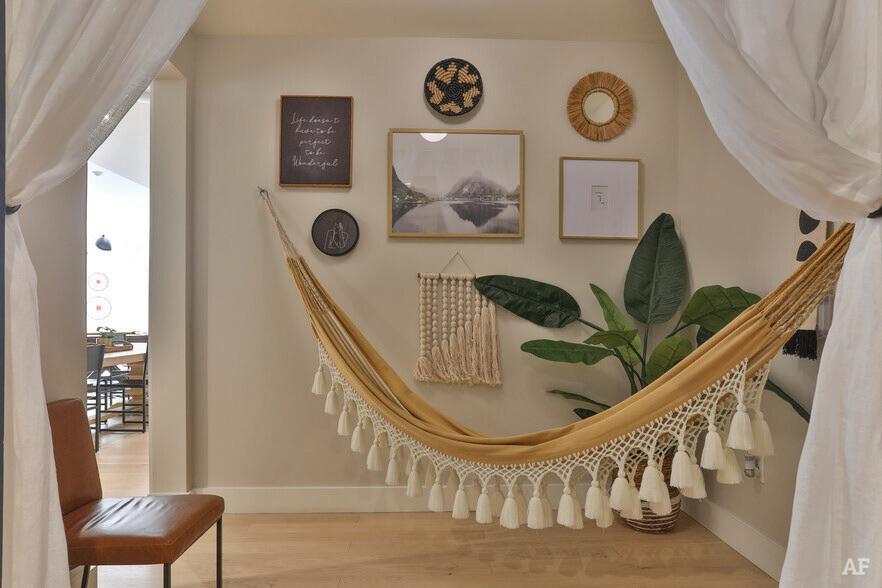

G I V E U S A C A L L T O D A Y ( 8 0 3 ) 9 8 6 . 7 2 0 0 O R V I S I T U S O N L I N E T H E 9 C O L U M B I A . C O M ! Sign a Lease Today! YOUR FRONT DOOR TO CAMPUS Luxury Apartments Townhomes, and Vista Location! Scan for our floor plans!
USC alumnae reflect on time spent in sports media, emphasize importance of diversity across platforms
Griffin Goodwyn | SPORTS EDITOR
Growing up in Charlotte, North Carolina, Alyssa Lang looked up to the United States women’s national soccer team, which was the best team in the sport at the time.
Lang said she would frequently watch a documentary made about the team, “Dare to Dream,” before soccer tournament games as a source of motivation and inspiration.
Since then, Lang has worked for media outlets in Columbia, Jacksonville and Charlotte and gained experience covering a number of sports. At one point, she actually considered leaving the sports media industry. She was in the third round of interviews for an entry-level sales position, she said, before her dream job at ESPN came calling.
Lang is now a host, anchor and reporter at the SEC Network and a prominent female figure in the sports media world, She has a following of thousands of girls who want to be like her one day — just as she looked up to female on-air personalities, such as Erin Andrews, at a young age.
She and other USC alumnae are using their platforms to support and inspire the next generation of women in the sports media industry.
Tori Richman, a team photographer for the NFL’s Tampa Bay Buccaneers, also looked up to the United States women’s national soccer team when she was younger. Like Lang, Richman played soccer until she was in high school and grew up wanting to be a professional soccer player.
Despite being a lifelong admirer of sports, the thought of having a career in sports outside of being an athlete never crossed her mind until she joined The Daily Gamecock as a photographer.
It was there that she developed a strong love of sports because “everyone can be a part of it.”
But this has not always been the case for women, Lang said.
Lang said she “has less room for error” because she is both an on-air sports personality and a woman in that profession.
She said her male counterparts are singled out by viewers as “someone who shouldn’t talk about sports” whenever they make a mistake on air. When women make similar mistakes, however, some of those same viewers make “blanket statements” about women, claiming that none of them should be talking about sports, she said.
Richman said she has run into situations in her work life where she was not taken seriously because of her size and gender. She said that when she was first hired by the Buccaneers, the team was unsure about whether she should enter the locker room.
But the Buccaneers staff eventually gave her locker room access, and the team’s players made her feel that she belonged, even though she was initially nervous about being there.
“(A player) was like, ‘Come in, you’re fine. Come on in, you’re part of the team. Take a breath, you’re fine,’ and from then, it made me feel accepted,” Richman said. “I realized that if I keep that mentality of ‘(Even if) I’m different or I’m on the outside, I’m here to do my job just the same, and I’ll be damned if someone gets in my way.’”
Richman said she experienced another impactful moment regarding women in the sports industry when she watched a video interview of Lori Locust, who was an assistant defensive line coach with the Buccaneers at the time. During the interview, Locust described sports as a “male-prevalent” profession, rather than
Richman has since adopted a similar mindset about navigating a profession that has historically been male-heavy, she said.
“Sure, there’s a lot of guys around, but I don’t ever feel or allow myself to feel that men dominate me,” Richman said. “I got here for my talent, for my skill, for my hard work, and I don’t have to prove (myself) to anyone else.”
Numerous professionals in the sports media industry have noticed that more sports workplaces are becoming increasingly populated by women and, in some cases, have become “female-prevalent.”
Shelby Beckler is the social media coordinator for Charlotte FC in Major League Soccer, where she oversees the creation and publication of the club’s content across various social media platforms. She said it is exciting to see professional sports organizations such as the one she works for move toward hiring more diverse staff.
“There’s people who have broken the barriers that we need, and I think it’s really cool to see,” Beckler said. “I’m pretty sure that Charlotte FC ... (has) more females than male staff, which is just crazy to think about. And so it’s really cool to be surrounded by just a wide variety of people, male and female, but it’s cool to see people (think) ‘If you see her, you can be her.’”
For Paige Davoren, a social media coordinator at the Premier Lacrosse League, working in a female-heavy subsector of the sports media industry
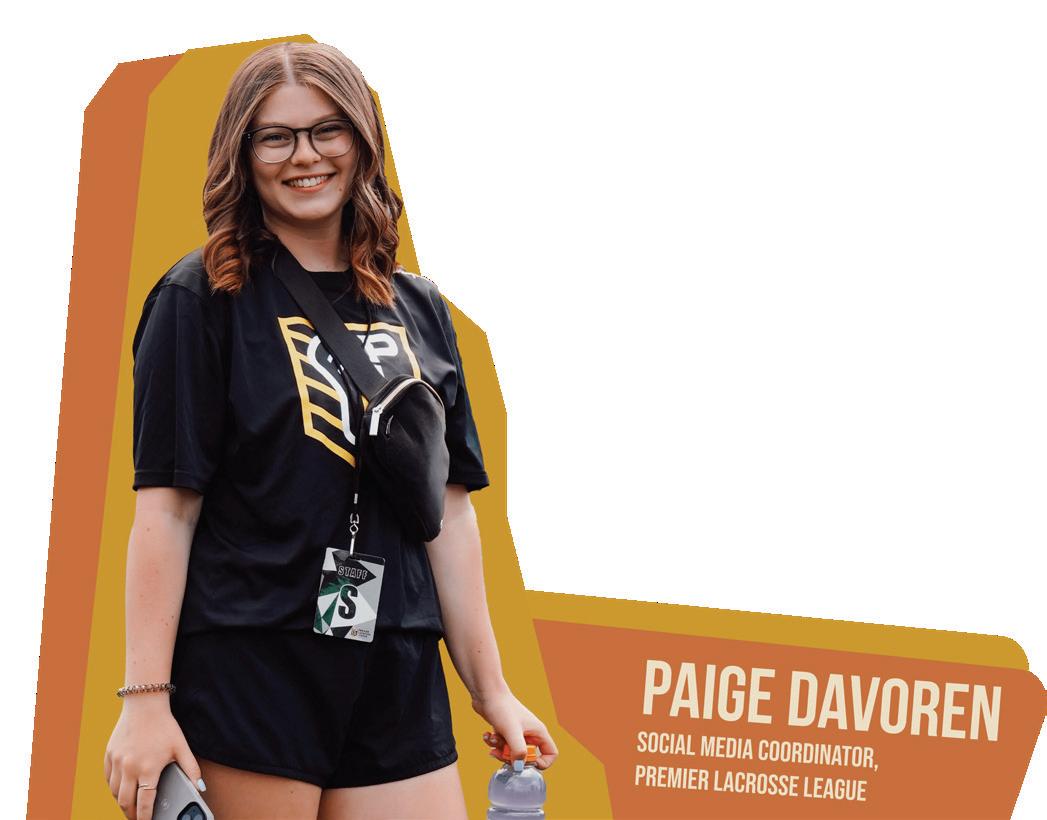

has provided her with a network of support. She said she can reach out to other women in social media for advice about both work-related and personal situations.
“It’s just that extra level of comfort that you automatically feel of knowing that they’ve probably been through some of the same experiences as you and can relate on a different level,” Davoren said.
Richman has created a similar support system through an Instagram group chat with other team photographers working for NFL teams, which has grown from four members to more than 10 since she was hired by the Buccaneers. The group chat now includes some part-time photographers and interns, as well.
“What’s awesome, especially with the women in that group chat with me, is we all have such different personalities, and we come from different backgrounds that the different kinds of women that we’re able to reach out to just from our own experiences, we reach that many more,” Richman said.
That level of support has not always existed in the sports media industry, Davoren said, which is why she hopes that women in sports continue creating a supportive culture to help the industry continue its trajectory of growth in terms of diversity.
“Being willing to take that extra step and — if people reach out to you — help them or give them advice, and do whatever you can,” Davoren said. “We’re only going to get to where we want to be in this industry if we are supporting each other.”

 Photo graphic: Anna Ottinger
Photo graphic: Anna Ottinger
Women’s basketball forward Ashlyn Watkins sees growth, increased playing time in 2nd collegiate season
Kyron Williams| SPORTS WRITER
The South Carolina women’s basketball team has started the 2024 season 29-0 as of March 3, and it has previously relied heavily on standout talent to reach that mark.
After the 2022-23 season, four of the five Gamecock starters at the time were drafted into the WNBA. The loss has carved out larger roles this year for players such as senior center Kamilla Cardoso, sophomore guard Raven Johnson and sophomore forward Chloe Kitts.
Each of these players has stepped up to fill those shoes, but some of them have unexpectedly missed a few games. Now, other South Carolina players have had to fill their absence — one being sophomore forward Ashlyn Watkins.
Watkins has emerged as a future star for the Gamecocks in her teammates’ absences, helping her hometown team and contributing to its recent run of success with her improved scoring ability, rebounding tenacity and defensive prowess.
Watkins hails from Columbia, South Carolina, where she played four years of varsity basketball at Cardinal Newman High School. There, she helped lead its women’s basketball team to four consecutive 3A state championships and became the school’s all-time leading scorer and rebounder. As a senior, she was named a McDonald’s AllAmerican and South Carolina’s Gatorade Player of the Year.
Watkins was a highly-touted recruit coming out of high school and was ranked as the No. 12 prospect in the country. She had offers from many high-profile programs, such as Kentucky, North Carolina, LSU and Louisville, but she ultimately signed with South Carolina during her senior year.
Watkins had limited playing time during her freshman season in 2022, only averaging about 10 minutes per game. But that didn’t stop her from producing highlight-reel plays, including the first dunk in program history against Clemson in November 2022.
Her playing time has since doubled, and she has showcased her offensive and defensive capabilities multiple times this season. She recorded her fifth doubledouble of the season on Feb. 4 against Ole Miss, recording 11 points and 10 rebounds to go along with one steal and one block.
“I feel like I’ve grown,” Watkins said. “I feel like I’ve been more disciplined. I would say, like on defense and offense.”
Watkins is averaging almost 10 points and more than seven rebounds per game as of March 3. Head coach Dawn Staley said Watkins can still improve even further on offense, however.
“We want her to score. There’s no question that she rebounds the basketball. She defends like no other. I think the one element that’s missing in her game is just consistently scoring,” Staley said. “We are being very calculating in giving her the ball and see what she does with it. She’s got to familiarize
herself with spots on the floor where she can be effective offensively, and that takes experience.”
Watkins said she has also seen herself make strides in improving on the defensive side of the ball. She has contributed an additional 1.2 steals per game to a South Carolina defense that ranks top-10 in the country and No. 1 in the SEC in points allowed per game.
During South Carolina’s game against Kentucky on Jan. 15, Watkins put up 10 points, eight rebounds, three assists, two steals and two blocks, showing off her versatility as a player. She also electrified the crowd with a dunk on a fast break.
“It meant a lot to me, especially doing it here in Columbia,” Watkins said. “Doing it for my family and my friends, everybody that came to support me at this game.”
Freshman guard MiLaysia Fulwiley, a fellow Columbia native and friend of Watkins since elementary school, praised Watkins for her accomplishments
this season after their win against Ole Miss on Feb. 4.
“It’s crazy just seeing her go out there and do that. I mean I knew she was capable of it, so when coach told her she had a start, I feel like we all knew that she was going to go out there and do what she does best,” Fulwiley said. “I feel like she’s brave. She’s not scared of anything, so when I know that she’s going on the court, I just know she’s going to do the right thing.”
Staley said Watkins’ recent success could warrant an increase in playing time with postseason basketball on the horizon.
“I’m super proud of her because she wasn’t a starter, and I know she wanted to start. And it bothered her to a point of actually showing me what we’re missing out on with her not starting. And I don’t want to start any friction, but we have to have Ashlyn on the floor,” Staley said. “She’s grown from Kamilla’s absence.”
 PHOTO: Mike Ranly
PHOTO: Mike Ranly
 Sophomore forward Ashlyn Watkins and head coach Dawn Staley share a hug during a ring presentation ceremony for the Gamecocks’ SEC Championship and Final Four appearance in the 2022-23 season. Watkins has taken on a larger role within the team in her second collegiate season.
Sophomore forward Ashlyn Watkins and head coach Dawn Staley share a hug during a ring presentation ceremony for the Gamecocks’ SEC Championship and Final Four appearance in the 2022-23 season. Watkins has taken on a larger role within the team in her second collegiate season.

USC research team pushes back on hair discrimination through on-campus efforts, CROWN Act advocacy
CJ Leathers | ARTS & CULTURE WRITER
Zion Crichlow, a first-year doctoral student, has been training to become a licensed clinical community psychologist during his time at USC.
He focuses on ways to help minorities, such as Black men or members of the LGBTIQIA+ community. Crichlow is helping to do just that through a project using on-campus data.
Through his research, Crichlow and a team composed of graduate students and professors are looking into the effects of hair discrimination on collegiate Black men and their mental health.
The hope is that the team’s research will help get the Creating a Respectful and Open World for Natural Hair Act, known as the CROWN Act, passed. The bill prohibits hairbased discrimination, which denies potential employment and education opportunities for Black Americans because of their hairstyles.
For Crichlow, who is a Black American, the research topic is one that carries personal weight. His first experience with being discriminated against for his hair was at 17.
cut your hair. You will never be able to have a career. No one is going to take you serious with dreads. That’s not professional,’” Crichlow said. “I can’t tell you how many times I was told so many negative messages just because of my hair.”
Crichlow and the team have found that the modern workplace divides workers and sets unrealistic expectations for employees, specifically those with distinct hairstyles, forcing Black men to cut their hair to be able to work.
Among all racial groups, Black Americans face the most backlash about their hair, said Guillermo Wippold, a health promotion researcher and associate psychology professor at USC.

“From 17 to 25 or 26, I can’t tell you how many times I was told, ‘You’ll never be able to get a job. You have to

identify as collegiate, Black American males across South Carolina’s Historically Black Colleges and Universities and USC.
Wippold decided to focus on Black men for the project due to there being a lack of research surrounding Black men specifically, he said.

The reason for the project is for the voices of Black men to be heard, Crichlow said.
“It’s to really work on projects and research tailored to the experiences of Black men, being able to give them a voice, participate in research — also with researchers from here,” Crichlow said.

Distinct Black hairstyles such as locs, cornrows and braids are often seen as unprofessional and unable to be worn to work, he said.
“The actions of other people may not express discrimination against it,” Wippold said. “They may worry and say, ‘Is this person trustworthy?’ or something like that.”
Diffferent forms of hair discrimination have been gaining momentum for years, according to the Economic Policy Institute, but Wippold said there is a way for discrimination to be prohibited through the CROWN Act.
The CROWN Act has been passed in many states, including Tennessee, Virginia and Texas, Wippold said.
He said eventual progress comes with backlash, however. The Black American community needs to engage and participate all across the state, or else government agencies won’t see the reason to engage with the issue, he said.
“If people like you, people like me, if the Black male students don’t engage or respond or participate, then one of the outcomes could be, ‘Well, if they don’t even care, why should we?’”

Wippold and the team are conducting a survey to gain information about whether hair discrimination leads to negative mental health effects. The survey is for people who
Crichlow said.
Kaylyn Garcia, a graduate research assistant and doctoral clinical psychology candidate, said getting participation from the USC community is helping them to gather more numbers.

Garcia said she and the team are not only gathering numbers, but are looking to appeal to the minds of government officials by telling relatable stories and experiences. She and the team are looking to have group discussions where people can tell their own stories.
Crichlow said electing strong political leaders who care for the Black community is also important. They are the ones who have the power to enact change, he said.
“It’s a matter of electing well enough to say that this is important and this matters,” Crichlow said. “And for our survey, in this instance, saying that it is really important for us to hear our voice from our men, our Black men.”
Crichlow and the team are hoping to continue their efforts around campus while spreading word about the CROWN Act.
“We know what it takes to pass policy, and it takes numbers, unfortunately,” Garcia said. “The more data that we can get to illustrate people’s experiences and to help tell their story is helpful.”
“No matter what happens with the survey, with the CROWN Act itself, we’re not going to stop,” Crichlow said.
ILLUSTRATION: CALLIE HRIBAR
Public murals, sculptures connect Columbia artists to community
Macaila Bogle | ARTS AND CULTURE EDITOR
All around Columbia, tall buildings, trains and USC’s campus tend to steal incoming visitors’ attention.
But take a closer look, and around a few corners, there are murals and sculptures decorating the sides of the roads.
Some of the city’s local artists said the public art helps to make Columbia a more beautiful place to live and brings together the community and the local artists who create these pieces.
Thomas Humphries, a local artist and business owner, is the artist
behind the “Recycled Life” sculpture at Riverbanks Zoo and Garden.
The metal lion that stands guard in front of the lion enclosure was made using Humphries’ knowledge of welding to create “found art” — a type of artwork made using discarded and recycled items.
Humphries took up recycled art as a college student.
During a welding class, Humphries started to fall behind on a project that was due soon. He said he quickly put together a statue of a man standing on his hands, which the class loved.

Humphries has since enjoyed the medium, he said.
Unconventional art such as his lion sculpture can create excitement and diversity in the local art scene, he said.
“The medium I like to use, which is the found pieces — I think it brings a little more neatness to it for people to enjoy seeing stuff used in a way they never thought about it being used,” Humphries said.
Humphries has created similar sculptures, such as a giraffe and zebra, in this style.
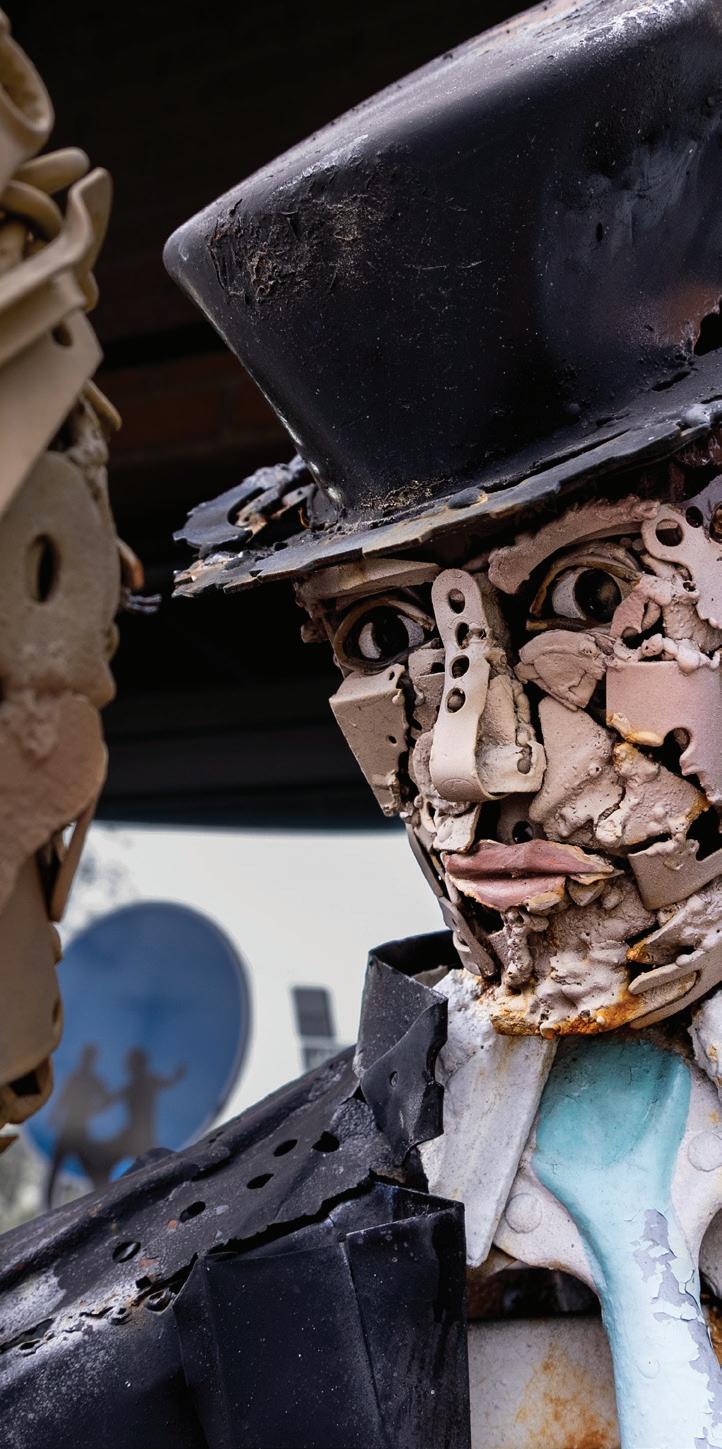
An affiliate of Riverbanks Zoo and Garden, upon seeing his animal sculptures, reached out to Humphries’ sister-in-law to inquire about the lion. While the sculpture is currently owned by Humphries, he said he is in the process of donating it to the zoo so it can be a permanent fixture there.
Living in a city with public art gives him the opportunity to peer into the lives of other artists in the area, he said.
“I think it’s neat to have a local connection,” Humphries said. “(It’s) like, ‘Hey, people in our town made this.’”
Cedric Umoja-Day is a multidisciplinary Afro-futurism artist. He has created paintings using wheat paste and spray paint, some by himself
Columbia’s diverse public art creates beauty of all different
“I like that we see different styles, different ways of painting, different expressions,”
Umoja-Day has painted two murals in Columbia. “Mural on Millwood,” located on Millwood Avenue, consists of several murals under the names “Something for Us” and “Love, Peace, and HipHop.” His other mural, “Untitled,” is painted on the side of A Peace of Soul Vegan
 A tribute to Anna Hyatt Huntington’s work, created by Thomas Humphries, stands on the South Carolina Fairgrounds, on Feb. 27, 2024. Humphries has several pieces on display at the Fairgrounds, including a Palmetto tree that stands on the corner of George Rogers Boulevard and Rosewood Drive in front of a welcome sign.
PHOTO: Alicia Caracciolo
PHOTO: Alicia Caracciolo
A sculpture of two dancers, created by Thomas Humphries, sits at the entrance of Blue Moon Ballroom in West Columbia on Feb. 27, 2024. Humphries made the piece without any specific buyer in mind, but the structure was a good fit for the ballroom company.
A tribute to Anna Hyatt Huntington’s work, created by Thomas Humphries, stands on the South Carolina Fairgrounds, on Feb. 27, 2024. Humphries has several pieces on display at the Fairgrounds, including a Palmetto tree that stands on the corner of George Rogers Boulevard and Rosewood Drive in front of a welcome sign.
PHOTO: Alicia Caracciolo
PHOTO: Alicia Caracciolo
A sculpture of two dancers, created by Thomas Humphries, sits at the entrance of Blue Moon Ballroom in West Columbia on Feb. 27, 2024. Humphries made the piece without any specific buyer in mind, but the structure was a good fit for the ballroom company.
Umoja-Day said murals such as these can improve an area’s atmosphere.
“It adds to the quality of life,” Umoja-Day said. “It allows citizens that dwell within that city to be able to experience art.”
Umoja-Day worked with two other artists, Brandon DonahueShipp and Karl Zurflüh, to complete “Mural on Millwood” in 2017, which was originally unfinished.
A different artist affiliated with City Year, an organization committed to helping make education more accessible, began the project. The mural depicted rows of houses and had a blank center.
Umoja-Daysaid thatwhen he noticed the mural had never been completed, he felt responsible as an artist to complete it.
“I used to pass this mural that was halfdone on Millwood Avenue ... I found out through some research that City Year had their hands in it, and it wasn’t completed because they couldn’t find enough funding to bring the artist back to complete it,” Umoja-Day said. “I felt like the community there needed a completed mural.”
The artist said he enjoys that people can experience public art without having to go to an art gallery or have deep knowledge on the subject. He said his art is touching without being shocking, allowing for people to connect with it.
“My art has always been in a space that everybody can engage with all the time,” Umoja-Day said.
Art should be accessible and easy to experience while also being something people can connect with without analyzing its technical value, he said.
“It’s really more so about: How does it make you feel?” Umoja-Day said. “What do you get from it as you’re experiencing this? More so than some super analytical, super hyper-intelligent type of response ... I think that all responses are intelligent when it comes to creativity.”
Umoja-Day said he considers the values of the community where his art will be placed, as he wants to respect the community’s past and present while creating a vision for its future.
“All murals aren’t the same,” Umoja-Day said. “Depending where the area’s at —


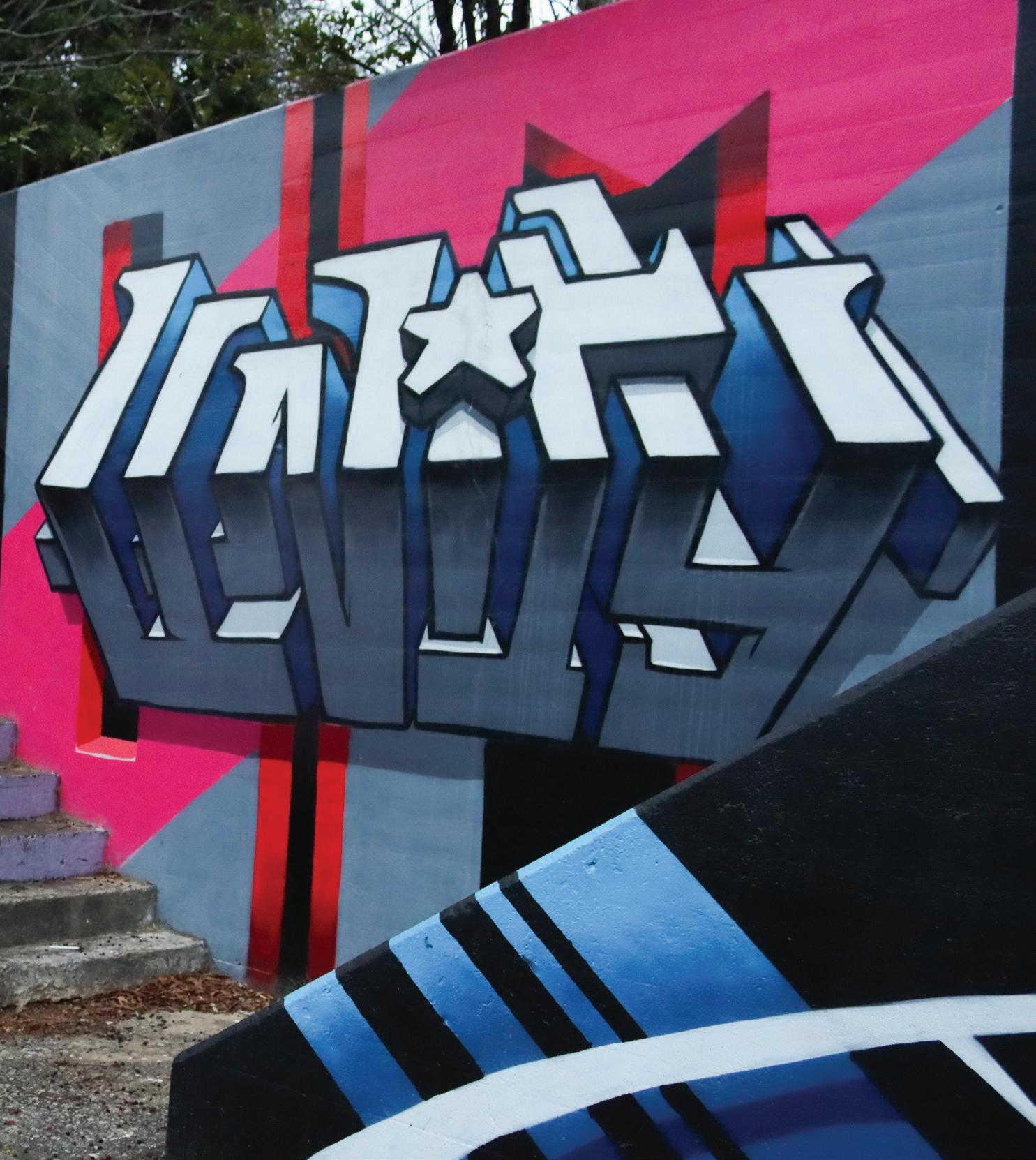
that’s going to be what the community calls for.”
Umoja-Day said his intentions are always the same when he goes to create a work of art. He seeks to move people and keep his art true to himself.
“I make the kind of art where you are going to get a response, but I’m not going to shock somebody with it,” Umoja-Day said. “I want to make sure it is consistent with who I am.”
Clay Wooten, an artist and woodworker, has been in the Columbia art scene for 15 years.
Wooten’s public art in the area includes several murals and a sculpture. He has one mural on Millwood Avenue titled “Woody the Fox” and another at EdVenture Children’s Museum.
Public art allows a venue for local artists to display their art while creating
a brighter area for the people who live there, he said.
His piece “Her Heart,” located in the Vista, is a sculpture composed of quarterinch steel rods that were hand-twisted into an anatomically correct heart. The piece represents the heart of Anastasia Chernoff, a well-known Columbia artist and gallerist who died in 2016. The work was meant to show that Chernoff’s heart was “big and open,” Wooten said.
Chernoff helped Wooten get his start in the area by inviting him to display his art in her gallery, which was his first Columbia art show.
Wooten said the support between artists is one of the reasons why Columbia is a valuable place for public art. Chernoff uplifted Columbia artists and provided them with a
space to learn and display their work, Wooten said.
“(Columbia’s) got that small-town feel, so the artists are known around that area,” Wooten said. “It helps the local artists to show off their work.”
Humphries said he would like to see more public art in the Columbia area. Prioritizing public art could create more space for artists in Columbia and more entertaining street sides where residents can see the hard work being put in by other locals, he said.
The city could always use more art, and Columbia seems to grow more aware of this potential every day, Humphries said.
“The more the merrier. It couldn’t hurt to have a more consistent focus on trying to share the art that is made locally,” Humphries said. “I think it’s just kind of neat to have more art around than less.”
“Love, Peace and HipHop,” created by Cedric Umoja-Day, Brandon Donahue and Karl Zurfluh, sits on Millwood Avenue on Feb. 27, 2024. The mural is one of many public art pieces around the city.
A mural created by Cedric Umoja-Day, Brandon Donahue and Karl Zurfluh sits on Millwood Avenue on Feb. 27, 2024. Umoja-Day is a local multi-disciplinary Afro-futurism artist, who has created paintings using wheat paste and spray paint.
PHOTO: Delany Kral PHOTO: Delany Kral
Columbia’s historic churches provide insight into past, continue to grow, change with new members
DAMIAN BERTRAND | ASSISTANT ARTS & CULTURE EDITOR
Inside Trinity Episcopal Church’s cathedral, detailed stained glass and large arches surround the grand building.
While it looks like it was built recently, the cathedral is nearly 50 years old, and the church’s history dates much further back, all the way to the 19th century.
Columbia is home to many religious buildings, some dating as far back as the city’s beginnings. These historic buildings have stood tall as the city around them has changed and expanded.
Trinity Episcopal Church is the oldest still-standing church in Columbia.
1811 and 1812, it is one of the few churches that survived the destruction Columbia faced during the Civil War.
Sitting at the corner of Senate and Sumter streets, it is believed to be the geographic center of Columbia, marked by a metal pipe sticking out of the ground in its graveyard, said Connie Britt, a retired docent.
Britt has been a church member since 1992 and acted as a guide for the church in her position. She was first invited to Trinity by her friend on Christmas Eve
and realized Trinity was meant for her, she said.
“It was such a beautiful service, and I just loved it,” Britt said. “I’ve been here ever since.”
Britt started getting more involved with Trinity and eventually worked at its bookstore. She used to be a history teacher, and once she retired, she decided to become a docent, where learning history goes hand in hand, she said.

it expanded in 1840 with the construction of the central part of the cathedral that is there today.
Britt said she witnessed the restoration of the church’s stained glass windows, foundation and the creation of several new buildings since she has been a member.
The cathedral is one of the earliest examples of Neo-Gothic architecture in the country, Britt said. The pointed arches, stained glass windows and pointed towers are influenced by European design.

Britt has seen the building grow immensely during the more than 30 years she has been with the church. She said the church started out on the northwest corner of the block and has now expanded to the whole block.
“They say one of the signs of a living organism is that it continues to grow,” Britt said. “And that is certainly true of Trinity.”
The original church was just a little wooden frame building, Britt said. Once more people started attending the church,
While its grand design impressed Britt, she said the church is meaningful to her because it was there for her during an emotional time.
“It was a new point in my life when I retired from teaching. My mother passed away, and my life was sort of starting over,” Britt said. “That’s what brought me to where we are right now ... a great deal of my life is now involved with Trinity.”
The size of the congregation kept growing, making it necessary to expand the building again in the 1860s, Britt said.
Trinity’s proximity to the Statehouse and USC, as well as its many different services, led to the growth of the church’s congregation because many students and professors attend its services, she said.
When the church closed for the coming expansion, the Civil War began, Union Major Gen. William Tecumseh Sherman invaded Columbia in 1865 with his men and started fires by shooting flaming balls of cotton that destroyed many buildings.
Trinity was not one of them.
Because of the costs of the expansion, Trinity could not afford a wooden roof like other churches and had to make do with a cheaper tin roof. Britt said divine intervention and the metal roof prevented Sherman’s fire from spreading to Trinity.
“It was the Lord’s miracle, because those balls of cotton didn’t slide in between the sheets of tin,” Britt said. “So

we did not burn down.”
Holy Trinity Greek Orthodox Cathedral is another church with deep roots in its history.
Established more than 85 years ago, the church grew in size to accommodate the growing number of people attending, said Michael Platanis, the reverend father of Holy Trinity Greek Orthodox Cathedral.
The parish was built in 1936 on the corner of Franklin and Sumter streets, where the community prayed in a small house. The parish then moved to the first edition of the church, which was built in 1948 on the corner of Calhoun and Sumter streets.
“The people, obviously, who began this church, they were very poor, hard-working people,” Platanis said. “That little humble community became a cathedral, and it welcomes people into the downtown quarter of Columbia, South Carolina.”
Platanis said he admires and respects the church
Whitlock, the minister of administration for the First Baptist Church. Thirty years ago, in 1992, a new sanctuary was built to replace the original.
First Baptist Church in 1860 was the site where South Carolina delegates unanimously voted to secede from the country.
Even though the church’s property is filled with buildings and has grown considerably since its establishment, Whitlock said First Baptist Church is just as welcoming as any other church because of its services and spiritual encouragement.

The church had surrounding commercial and residential buildings torn down around it to help its expansion, Platanis said.
The construction of the cathedral’s largest church building started in 2009, which Platanis said was necessary for the future of the church. The congregation then conducted a study at the time and realized a larger cathedral was within its reach.
“We simply outgrew (the original building),” Platanis said. “People, at that time, realized that there’s a time to (expand), and if you don’t do it during that time, you miss that opportunity.”
Platanis said that even though the cathedral is not as old as others in Columbia, the growth of the church is something to be noticed, and the community will continue to build on the traditions of previous generations.
and the generations of worshippers before him because of the traditions of service they established.
“They lived according to the same traditions we live according to, so there’s a very beautiful line of history,” Platanis said.
Near the heart of Columbia, the First Baptist Church of Columbia is another one of the oldest churches in the city.
The Church of Columbia was first organized in 1809. The church then opened up its building in 1811 on Sumter Street.
The original church was replaced with its oldest sanctuary in 1859, said Buster
With Columbia’s rich history spanning centuries, these churches have expanded and changed with the city. As the years go on, Britt said they will continue doing so and grow with Columbia.
“We are still growing,” Britt said. “The size of the congregation has had peaks and valleys since I’ve been here, but right now it’s at a growth spurt.”
“We’re a pretty big church that feels like a small church,” Whitlock said. “(It has a) very personal feeling and (is) warm and friendly.”
 LEFT PAGE — The inside of Trinity Episcopal Cathedral’s main sanctuary sits on Senate and Sumter streets on Feb. 22, 2024. The main sanctuary of the church boasts intricate stained glass windows and architectural grandeur, offering parishioners a space for spiritual reflection.
PHOTOS: DESTINI SIMON
RIGHT PAGE — The inside of the Holy Trinity Greek Orthodox Cathedral sits on the corner of Main and Richland streets on Feb. 22. The church has been around for more than 85 years.
PHOTOS: NICKOLAS HILL
LEFT PAGE — The inside of Trinity Episcopal Cathedral’s main sanctuary sits on Senate and Sumter streets on Feb. 22, 2024. The main sanctuary of the church boasts intricate stained glass windows and architectural grandeur, offering parishioners a space for spiritual reflection.
PHOTOS: DESTINI SIMON
RIGHT PAGE — The inside of the Holy Trinity Greek Orthodox Cathedral sits on the corner of Main and Richland streets on Feb. 22. The church has been around for more than 85 years.
PHOTOS: NICKOLAS HILL
Hey Gamecocks, meet...


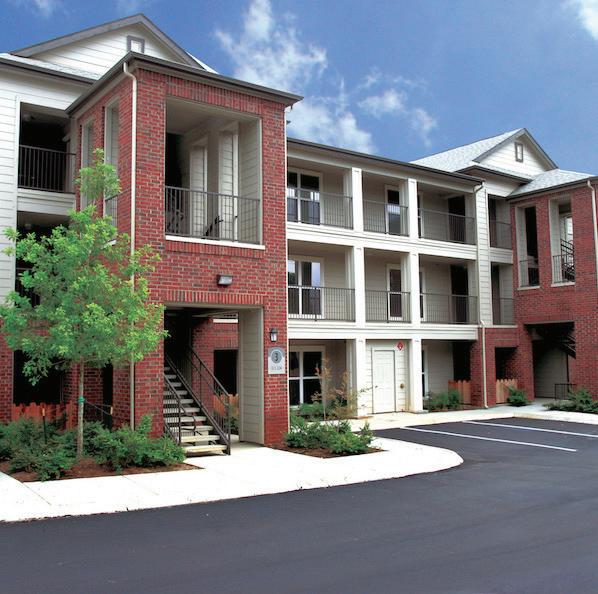


Column: Student Government is unable to make real change on campus, can’t fulfill campaign promises
VARSHA GOWDA | OPINION EDITOR
The 2024 Student Government elected executives aspire to bring change to campus by improving safety, infrastructure and Wi-Fi, but due to the organization’s intangible promises and internal problems, it will be difficult for them to accomplish these goals.
The way funds have been mismanaged in 2023 and 2024 has shown some of the incompetency within the organization.
With fewer than two months left in the spring semester, Student Government has almost completely run out of funds to allocate to student organizations. This is the second consecutive year this complication has occurred.
Of the $185,000 budget it received at the beginning of this fiscal year, Student Government distributed at least $149,000 to student organizations just over the course of the fall semester. It was proposed at the end of January that spending limits would be capped at $10,000 per fiscal year for each organization, but this was after at least four organizations received more than that budget.
Former speaker pro tempore, Ian Herd, stepped down from his position in November because he disagreed with how Student Government managed the money. The financial committee displayed a “lack of responsibility” when pushing financial legislation, he said.
Student Government needs to be more rational when making financial decisions. Allocating funds to student organizations is one of its primary responsibilities.
If the organization can’t fix these recurring financial issues, how is it going to effectively serve the student body?
In addition to these financial problems, all candidate positions this year were uncontested, which means there wasn’t really any point in students voting in the election. This reduces the student body’s interest in voting for future elections and eliminates the option for students to vote on which platform they think is the best. They are instead given one option,
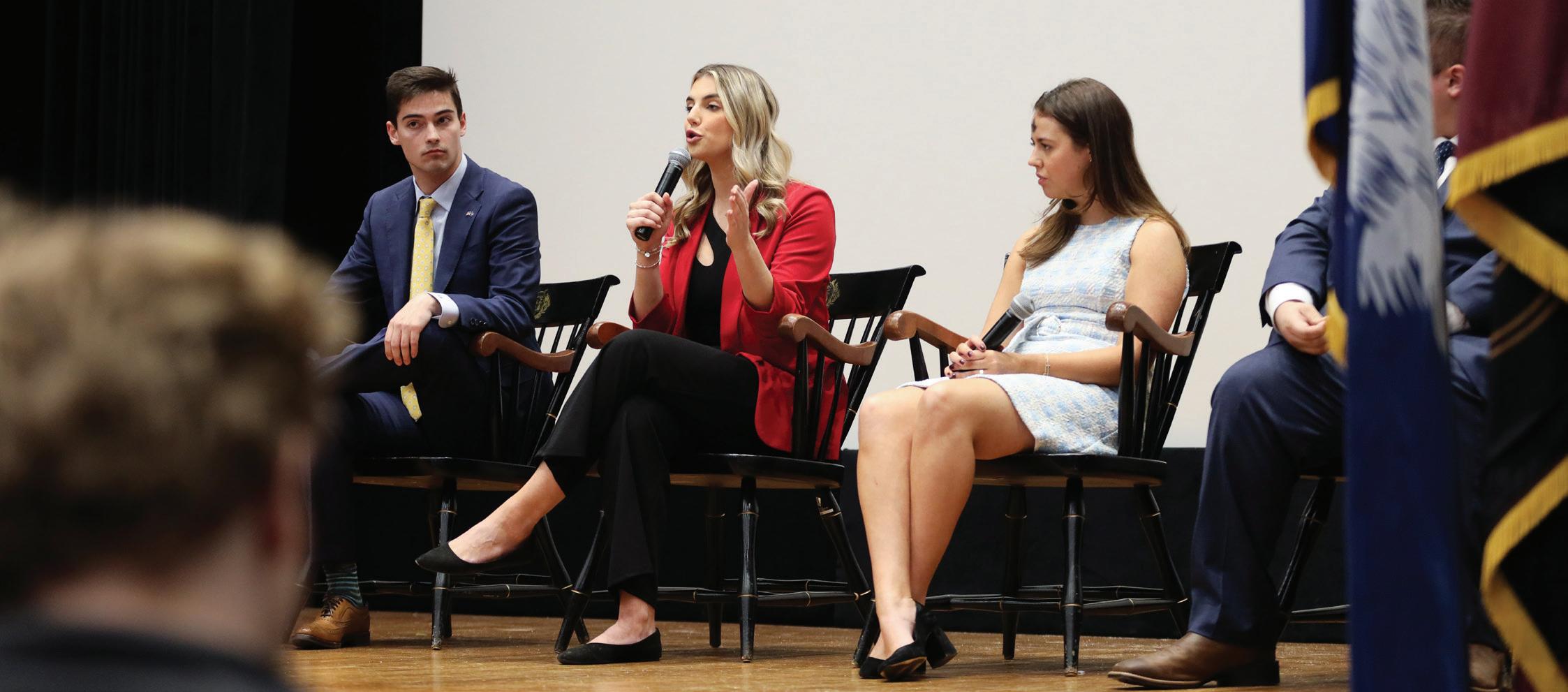
whether they agree with the goals of the candidate or not.
The Student Government election process also seems to be getting more and more streamlined each year.
The presidents who have been elected over the past two years have worked in their preceding president’s office. Student Body President-elect Patton Byars worked as chief of staff for President Emmie Thompson and former President Reedy Newton. Thompson also worked as chief of staff in the executive cabinet of Newton’s office before she was elected as president.
The presidential candidates who have worked in previous presidents’ cabinets have the upper hand in these elections. This discourages other non-presidential cabinet members from running in the election because the outcome of them winning is highly unlikely. Thus, the streamlining occurring in Student Government is limiting the candidate options students can vote for.
The elected executives have promised hefty goals — such as improving campus Wi-Fi, infrastructure and parking — without outlining any concrete plans for how to accomplish them.
“You can’t be a successful student without consistent and reliable Wi-Fi,” Byars said. “So that’s one thing I’m going to do. I understand how to work with administration, being a chief of staff, but I also understand that when administration says ‘No,’ that doesn’t mean I’m going to stop. I’m going to be a change agent for the university.”
Although Byars claims he wants to resolve campus Wi-Fi issues, repetitively asking administration to take action as a sole solution to this problem isn’t a reliable plan.
Despite not having reliable plans for improving Wi-Fi, Student Body Vice President-elect Courtney Tkacs has proposed a way to advocate for more upperclassman housing on campus.
“I work with the Leadership and Service Center,” Tkacs said. “We have a tracker of
everybody that calls us and voices their concerns about off-campus living. I would bring that to administration and let them see how many students do want to live on campus and just urge them to put more rooms aside.”
Although this appears to be a step in the right direction of advocating for more upperclassman housing, Tkacs’ plan still relies too heavily on having administration listen to concerns from Student Government.
In order for Student Government to be more effective in 2024, some real changes need to be made to help resolve the internal issues that persist within the organization.
Student Government leaders need to hold themselves accountable and make more achievable plans to resolve the issues they see on campus. They need to forge better relationships with the student body and faculty members in order to understand what specific problems persist in the USC community and provide realistic solutions.
FILE — Student Body Vice President-elect Courtney Tkacs answers a question during the Student Government debate on Feb. 14, 2024. Tkacs is a second-year public health and political science student.
PHOTO: SAVANNAH NAGY

Column: USC needs to make major improvements to its STEM buildings
Varsha gowda | opinion editor
The university is hoping to make some major renovations to campus. Some include potential plans for a new student union or changes to existing academic buildings.
But all of these hypothetical plans have one common denominator: The university is not prioritizing the existing STEM buildings on campus.
The university made some improvements for STEM faculty and students when it added the Science and Technology Building in 2020. This provided STEM students with more labs and classrooms supplied with the latest technology and equipment.
But USC still needs to update its older STEM buildings, as plenty of faculty and students use them every day.
These buildings host biology students, who make up the third largest major at USC, and many other highly populated majors, so the facilities are constantly being used.
The university needs to renovate these buildings to maintain a quality infrastructure for faculty and students to use.
The Coker Life Sciences Building, Jones Physical Sciences Center and the Earth and Water Sciences Building are some of the main science buildings on campus.
Eric Tappa is a research associate in the School of Earth, Ocean and Environment. He said the Earth and Water Sciences Building’s infrastructure can’t adequately handle the needs of researchers working in that building.
“It needs to be torn down and rebuilt,” Tappa said. “It’s a 40-year-old building that can’t handle most of the instrumentation we have.”
There are constantly things needing to be changed because of the old infrastructure, Tappa said. Working in the building, he has noticed that some counters require a lot of lead shielding, and because of that, the building has to be strengthened.
The building isn’t even sustainable enough to maintain the research facilities for professors to conduct work. Even with some of the smaller updates to

the buildings, professors are unable to properly use the equipment.
Thomas Vogt, a professor in the chemistry and biochemistry department, does research using electron microscopy at Coker. He researches in a $5 million facility that requires a low temperature to function, so it is important that the air handlers and temperature control work well.
“We cannot do measurements at this microscope to its capability because we do not have the temperature concept, and that has to be related to two things,” Vogt said. “It’s related to the fact that the infrastructure is very old, and it’s related to the fact of how the building is actually being run.”
The university advertises itself as “one of the country’s leading research institutions“ and emphasizes the value of the research being done at USC.
But it doesn’t provide adequate facilities for the professors doing the work to make this a well-established research institution. This is unfair to the professors who work hard to conduct their research and contribute to USC’s status as a flagship university for research.
The university needs to make sure it is providing sufficient infrastructure for professors teaching and researching in these buildings by listening to their complaints and making adjustments.
“I think the classrooms just need to be remodeled because they’re terrible,” thirdyear pharmacy student Shahd Abdeladl said. “The ceilings are old, the walls, everything, the desks. There’s nothing that doesn’t need to be fixed.”
The university needs to value its students and provide them with the resources for their future success, especially those in graduate programs working in the laboratories or taking classes in these buildings.
“Our student lounge is packed with people, there’s not even room for half of us to sit,” Abdeladl said. “We do not have enough space at all. There’s like two classrooms for 400 students.”
PHOTOS: MAGGIE JONES
A student sits in a study area inside the Coker Life Sciences Building on Feb. 22, 2024. Coker is the home of the USC Department of Biological Sciences.

Students spend time in one of the common spaces in the College of Engineering and Computing on Feb. 22, 2024. Swearingen
USC’s College of Pharmacy, which is located in Coker, is one of the largest and oldest pharmacy schools in South Carolina, yet it still can’t accommodate the needs of students.
Different healthcare professional students have their own buildings, such as those in the medical school and nursing school. Both of these professional schools are getting new buildings with new facilities.
The least the university can do for the pharmacy students is add more classroom space and update the facilities within Coker and the rest of the buildings. Better architectural planning could be used to provide more study spaces for these graduate students.
“One thing I have noticed is, in the Jones building, there’s not like a single water fountain in sight, so I always end up having to walk over to Coker to fill my water and stuff like that,” second-year biology student Layth Yousfi said.
With tons of students attending classes in these buildings, they need to have better access to water fountains, with more water bottle fillers, to make sure they stay hydrated. Keeping these fountains in out-of-sight crevices is a nuisance for people in the building, so the issue needs to be resolved.
“I honestly think the bathroom stalls, everything needs to be redone. If you go to the second floor, that bathroom is falling apart,” first-year undeclared student Francelis Rivera said.
The lack of proper bathroom facilities in Coker and Jones is pathetic. There are multiple faculty members and students who are in and out of the bathroom every day, yet there doesn’t seem to be any rush to update these necessary spaces.
There also needs to be more bathrooms in place, especially for women, to accommodate the faculty and student needs.
For both faculty and students, the building does not provide a conducive environment where work and learning can take place.
It is not as if the university lacks the budget to improve these buildings. The university has recently proposed to rebuild USC’s student union, and one estimate showed that the building could cost $240
million. Instead, some of the money could go to maintaining the infrastructure of its academic buildings and improving its facilities.
The quality of education the university strives for needs to match its infrastructure to show how much it values its faculty and students. Faculty and students shouldn’t have to deal with these subpar facilities. They deserve an environment that fosters advanced technology and good infrastructure.
The university needs to reevaluate its priorities and invest more in its STEM buildings across campus for the betterment of STEM faculty and students.
Engineering Center is one of the largest engineering facilities in the Southeast.
Column: Expanding Greek Village, adding sorority chapters will improve USC’s Greek Life community
Morgan Dunn | OPINION WRITER
Greek organizations have long been pillars of collegiate culture, offering students a sense of community, leadership development and lifelong friendships. USC needs to expand Greek Village in order to allow the community to accommodate new members.
One thing that draws many people to USC is its Fraternity and Sorority Life.
Greek Life is very popular, with 4,156 active members participating in the College Panhellenic Association as of 2022. These organizations not only offer social opportunities but also provide a tight-knit community within the university where individuals can find comfort in their collegiate journey.
The increased enrollment in the student body brings in more students who are interested in rushing. USC Panhellenic Association in fall 2023 hit a record number of 2,000 girls who participated in sorority recruitment to join one of its 13 sororities. While this is a great number for the College Panhellenic Association, the ability to accommodate this many people interested in joining Greek Life is becoming a concern.
Having housing for every sorority and fraternity at Greek Village would make the
Greek Life experience feel more authentic. It would provide that sense of community for the members and build an intimacy within chapters that creates stronger friendships. The village is currently home to 20 sorority and fraternity chapters.
With the possible expansion of the Greek Village, the community would be able to accept a larger number of new members interested in joining. The expansion would entail building six additional houses in the village, bringing opportunity for more sorority and fraternity chapters to have on-campus housing.
The plan for more houses to be added into Greek Village could also serve as an opportunity to add new chapters to campus, which could soon be a reality, following a recent vote.
“The chapters of the College Panhellenic Association voted on the topic of extension on Monday, Feb. 5,” Coordinator of Fraternity and Sorority Life Haley Fern said in an email. “The vote passed with more than two-thirds of the chapters voting ‘yes’ for extension. Moving forward, CPA will work with the National Panhellenic Conference on next steps required in the process of bringing a new chapter to campus.”
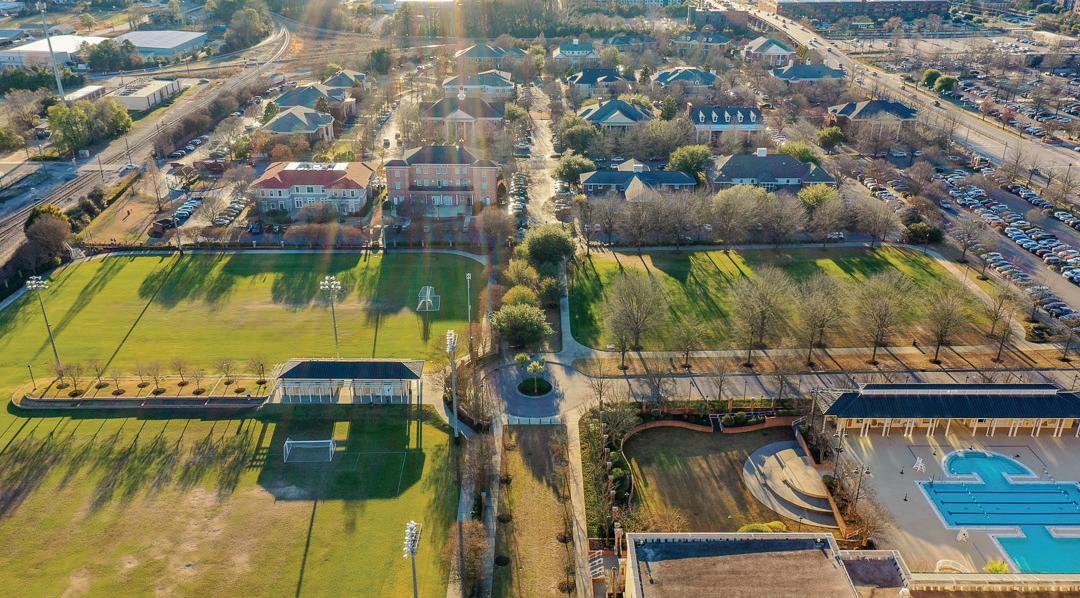
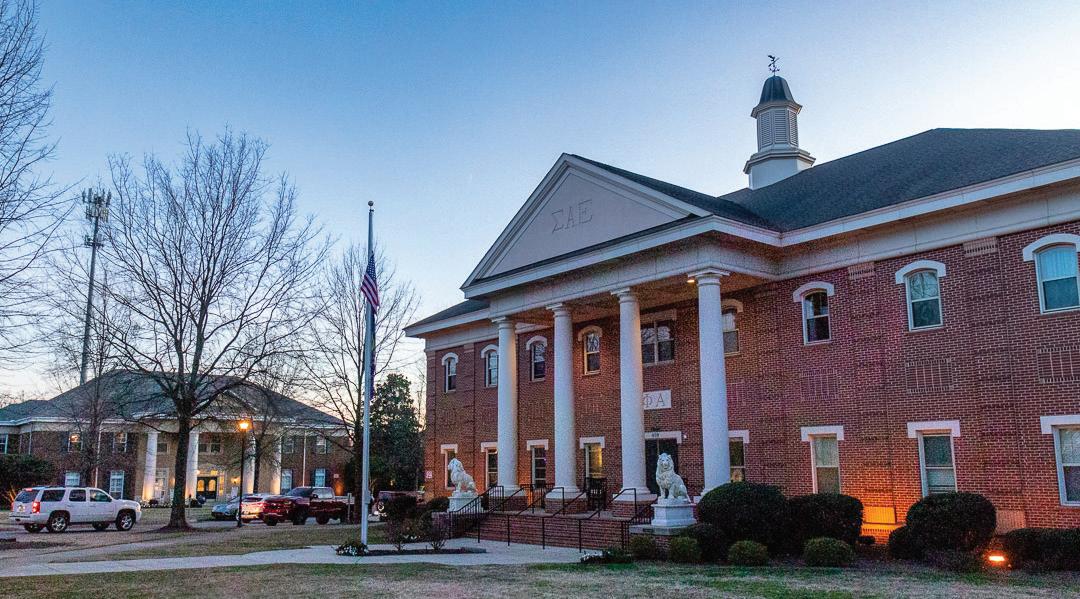
There are 23 fraternity chapters active on campus, compared to 13 sorority chapters. But there are only 2,835 fraternity members, compared to 4,156 sorority members. Since there is almost double the amount of sorority members compared to fraternity members, it would make sense if there were more or the same number of sorority chapters. But this is not the case.
Sorority chapters have huge populations that have never been seen before on USC’s campus.
The average number of girls in one sorority chapter is around 300 at USC. When one of the main focuses of being in a sorority is sisterhood, how can one truly feel that sense of sisterhood with such large chapters?
Bringing in new sorority chapters would produce smaller and more intimate chapters that would allow members to feel more like a family to each other. This would promote the “sisterhood” ideology that every sorority holds. With more chapters, there would also be greater diversity in the values they represent, allowing students to find groups that align more with their interests and identities.
Given the growing population of the school, resources need to be expanded, and this should include Greek Life.
Because Greek Village can only house a certain amount of chapters, two sororities have lost housing in the Greek Village this past year. The fraternities that originally owned the houses returned in 2023 and reclaimed them, kicking out the sorority chapters. The two sororities were forced to move their accommodations off campus. While these two sororities are thriving, it is unfortunate that the members lost their on-campus housing, and there is no way for them to relocate in the completely occupied Greek Village.
Having a house in Greek Village makes the experience of being in a sorority at USC more genuine through the community and intimacy it brings the members. This is why every sorority and fraternity should have the opportunity to have a house located in the Greek Village. It would give all of the chapters a tightknit community and allow them to be seen as equal.
Greek Life is a community where many have found their home away from home. With more people coming to the school, the expansion of this community would be uplifting for its members. More students would have the opportunity to find their sense of belonging at USC, and current chapters would have the opportunity to keep flourishing.
Photos: Xavier Martin
An aerial view of the Strom Thurmond Wellness and Fitness Center and USC’s Greek Village on Feb. 7, 2024. Plans are being made to expand Greek Village onto the multipurpose fields to meet the demand of the growing Greek Life population.
The outside of the Sigma Alpha Epsilon house sits in USC’s Greek Village on Feb. 7, 2024. Greek Village is home to 20 fraternities and sororities.


















Visit an office near you or RelaxJoinFounders.com to see if you qualify for membership today! MAKE YOUR MOVE WITH THE RIGHT TEAMMATE!

Column: Students often sacrifice healthy meals on campus due to costs. But this shouldn’t be the case
Jenna swenson | ASSISTANT OPINION EDITOR
College students should have access to more balanced, healthy meals on campus. A location where they are able to receive protein, vegetables and fruit altogether is needed to ensure students maintain their nutritional balance.
But here at USC, this feat is difficult to accomplish. These types of meals should be both affordable and available to all students.
USC has various meal plan options students can choose from, including a mandatory one for first-year residents,
which starts at $2,404 per semester. The option is the cheapest all-access meal plan, and it includes meal swipes which max out at seven per week. There are three other meal plans that also include meal swipes. One provides 10 per week, one is set at 100 per semester and the last one gives students 50 total for the semester.
The Education Data Initiative found in August that “a campus meal plan averages $450 a month.” With about four to five months in a semester, the $2,404 meal plan becomes about $480
to $601 per month. These inflated meal plan prices aren’t just present at USC. They have become a trend across many college campuses.
An article from U.S. News reported in 2022 that the average college meal plan ranges from $3,000 to $5,500 for an academic school year. The all-access meal plan here is $4,808 per academic year, resting on the higher end of that spectrum.
The Daily Gamecock surveyed students to get their opinions on

food affordability on campus. About 85% of over 40 students said they felt that USC’s dining halls are expensive.
Some of the more popular on-campus food options at USC are located in the six dining halls throughout campus. Every hall provides unlimited access to the food served after paying for entrance. Each hall costs $11 with tax to enter for breakfast, and $15.40 for lunch and dinner.
Meal swipes are valued at $10.50 for lunch and dinner time, which is about the average cost of a meal from restaurants and retail locations. The price difference between that and the dining hall entrance fee of $15.40 is unreasonable.
Outside of these halls, only Village Juice & Kitchen and Colloquium Café are standalone restaurants on campus centered around healthy eating.
The majority of fresh food on campus is bound to dining halls, such as fresh fruit stands and salad bars.
“In general, dining halls offer the most flexibility in terms of recipe design, implementation,” said Cody Ellis, a registered dietitian for Carolina Food Co.
Carolina Food Co. has more control over what is served and presented in dining halls than they do in retail locations. This allows for the inclusion of more healthy foods and the ability to provide whole, fresh foods, Ellis said.
While that jurisdiction is not unreasonable, it means students will have to first pay $15.40 to get a complete, healthy meal.
Carolina Food Co. does provide whole fruit in dining halls and makes sure it is available to purchase à la carte in stores such as Gamecock General.
But the reality is that those stores are not as consistently stocked as the dining halls. While the entrance fee does appear to be reasonable, considering there is no limit to the amount of food a student can take,
Photos: TAYLOR KITCHENS ILLUSTRATIONS: GRANT RICHA
Packs of sushi available to purchase at the Gamecock General store in Russell House on Feb. 26, 2024. The Gamecock General locations around campus offer a selection of packaged food, snacks, drinks and frozen meals.

cheaper prices, but they do not allow for a well-rounded meal.
Several of these restaurants do have vegetables on their menu, such as Colloquium Cafe’s spinach and tomato basil wrap option, but where they are lacking is in the availability of fruits and salads.
Many of the restaurants have limited choices when it comes to fruit, but Chick-fil-A does have two yogurt parfaits topped with fruit and a fruit cup available to purchase.
After freshman year, students can choose the same meal plan or explore other options. Students can switch to paying for meal plan dollars alone or fully out of pocket. Or, they could choose another meal plan that provides a set amount of swipes and meal plan dollars.
Another option is a declining balance meal plan, ranging from $500 to $1,625, which only includes meal plan dollars. Meal plan dollars serve as cash without the sales tax on on-campus food items.
Students often opt to use meal plan dollars to pay for campus convenience store items at one of the multiple Gamecock General locations, as well as Market 101, located inside the McBryde dorm building.
But these items tend to be sold at inflated prices compared to off-campus convenience stores. Mandarin oranges are sold at CVS for $1.29 and for $2.69 at Gamecock General. While this
Nevertheless, the trend needs to change so college students can eat healthy on campus without breaking the bank.
A 2018 article from CNBC found that 40% of college students said they are unable to afford balanced meals. This means that students are forced to compromise healthy eating habits for less expensive meals that may not be as nutritional.
There are numerous benefits of having a healthy, balanced diet.
The World Health Organization states that a healthy diet “protects you against many chronic noncommunicable diseases, such as heart disease, diabetes and cancer.” Eating well can also improve one’s emotional state, as stated in an article from the Washington Post, which found an association between high consumption of fruits and feelings of relaxation.
Students should not have to choose between eating healthy and saving money.
About 46% of USC students surveyed reported they do not have affordable, healthy food options outside of dining halls.
enough opportunities for students to receive a well-rounded meal that includes both fruit and vegetables in one sitting. While retail locations may have vegetable options, they lack fruit. And fruit is infrequently restocked outside of dining halls.
Ellis said Carolina Food Co. does not receive many complaints about a lack of affordable food options on campus very often.
There is a clear disconnect between students’ thoughts on the prices of food on campus and how Carolina Food Co. perceives the situation.
Most of the food options available outside of dining halls simply aren’t affordable or adequate for a balanced diet.
Additionally, the healthier options are largely overshadowed by sodas, microwaveable dishes and junk food. The numerous options for these food items outnumber the few options for fruits and salads.
common in different institutions across the country.
In a 2019 article for Forbes, Richard Vedder, a professor from Ohio University, recruited two of his students to compare the prices of common goods — such as toothpaste, Ramen noodles and gum at an oncampus convenience store and a local Walmart. They found that on average, the price of those select goods was 40% to 60% higher at the university store than at Walmart.
Campus food in dining halls and convenience stores both tend to be more expensive than dining off campus. The same article from Forbes reported that a potential reason behind this increase is due to colleges having monopolistic power, seeing as how universities often compel students to dine on campus and utilize their facilities.
About 80% of respondents also said they would like to see more affordable food options on campus outside of dining halls, referring to the items sold at retail locations and convenience stores
The bottom line is that students should be able to have food autonomy without compromising on cost. There should be more affordable on-campus food options in dining halls and campus convenience stores.
The university needs to do better in providing these options to students.

The Daily Gamecock sports staff predicts March Madness outcomes
The 2024 NCAA basketball tournaments present a unique opportunity for South Carolina sports fans. The Gamecock men’s and women’s basketball teams could both compete for a national championship for the first time since 2017.
With Selection Sunday on the horizon, two of The Daily Gamecock’s sports editorial staff members offered predictions for how both teams will fare in March Madness.
Griffin Goodwyn, sports editor
MEN: SWEET 16 EXIT
Picked to finish last in the SEC at the start of the season, South Carolina has been nothing short of surprising all season long, especially in wins over top10 teams Kentucky and Tennessee earlier in the season. Head coach Lamont Paris has built a team that has played impressive defense for much of the campaign, and its experience and grit will lead the Gamecocks to two victories in March before being bounced in the round of 16.
WOMEN: NATIONAL CHAMPIONSHIP WIN
The Gamecocks have been national championship contenders for the past decade and head into this year’s tournament as favorites to win it all. It’s hard to see any other outcome for this team, as it is the lone undefeated team in the sport, with talent and depth at every position.
Unlike past South Carolina teams, its offense is multi-dimensional, with senior center Kamilla Cardoso pounding the paint and senior guard Te-Hina Paopao hitting shots from deep. Barring any setbacks, the Gamecocks are looking at securing its third title in seven years.
MEN: ROUND OF 32 EXIT
It would be great to say that the team will go on another Cinderella run, just like it did in 2017, but that won’t happen. The Gamecocks are defensively sound, but when its defense falls apart, it gets beat badly, and its offense won’t be able to keep up with the top teams if the defense is lacking. The team will go out in the round of 32.
WOMEN: NATIONAL CHAMPIONSHIP WIN
Anything short of winning the national championship would be a failure. It’s hard to do that, but that is the expectation set upon a team that has been ranked since the second AP Top-25 Poll and has won the SEC regular season with three games to spare.

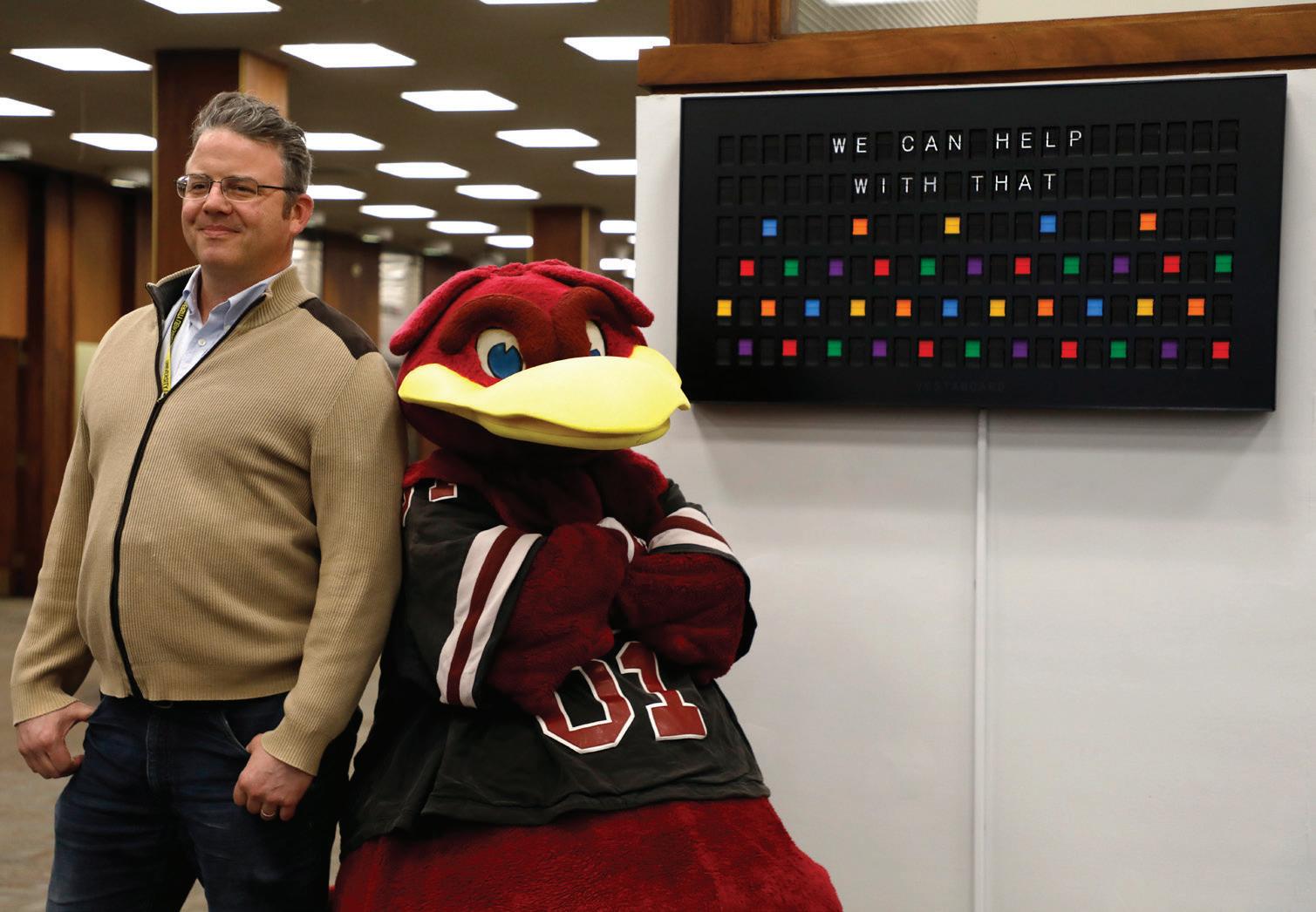

WITH THAT. GOT RESEARCH PROJECTS? • BOOK ONE-ON-ONE TIME WITH A LIBRARIAN • CHAT WITH A LIBRARIAN LIVE ONLINE • EXPLORE OUR EXTENSIVE GUIDES TO RESEARCH RESOURCES • EVEN CHECK OUT A CHARGER FOR YOUR PHONE OR COMPUTER WE CAN HELP
Will Kelly, assistant sports editor
ILLUSTRATION: GRANT RICHA


TOUR TODAY CAYCECOVE.COM | 215 SPENCER PLACE | CAYCE, SC 29033 | 803.244.9117 Subject to change, restrictions apply.

EDITOR-IN-CHIEF
Kate Robins
MANAGING EDITORS
Riley Edenbeck, Ava Rossini
CREATIVE DIRECTOR
Savannah Nagy
NEWS EDITOR
Emmy Ribero
ASSISTANT NEWS EDITORS
Marley Bassett, Win Hammond
SPORTS EDITOR
Griffin Goodwyn
ASSISSTANT SPORTS EDITORS
Annie Poteat, Will Kelly
ARTS & CULTURE EDITOR
Macaila Bogle
ASSISTANT ARTS & CULTURE EDITOR
Damian Bertrand
OPINION EDITOR
Varsha Gowda
ASSISTANT OPINION EDITOR
Jenna Swenson
BEAT WRITERS
Emma Davisson, Emma Edwards, Jaydon Ford, Will Miller, Carrigan Woodson
CO-DESIGN DIRECTORS
Callie Hribar, Anna Ottinger
SENIOR DESIGNERS
Clay Laucella, Grant Richa
CO-PHOTO EDITORS
Alicia Caracciolo, Taylor Kitchens
SENIOR PHOTOGRAPHERS
Delany Kral, Emma Wyatt
ENGAGEMENT DIRECTOR
Elena Keller
SOCIAL MEDIA DIRECTOR
Awani Bildikar
MULTIMEDIA DIRECTOR
Emma Connelly
COPY DESK CHIEF
Bridget Tracy
ASSISTANT COPY DESK CHIEFS
Elise Lo, Addison Scott
STUDENT MEDIA DIRECTOR
Sarah Scarborough
ASSISTANT DIRECTOR OF STUDENT MEDIA
Sydney Cranmer
ART DIRECTOR
Krista Larson
ADVERTISING ADVISOR
John Burbage
FACULTY ADVISOR
Brandon Shulleeta
CREATIVE SERVICES
Chloe Ehlers Lily Ferguson, Jada Mack, Savannah Nagy, David Olsen
AD SALES TEAM
Ariana Herbas, Biffy Skeels, Delaney Flanagan, Kylie Kurinsky
Sofia Sabatino, Marisa Tartamella Sofia Sabatino, Marisa Tartamella
EDITOR sagcked@mailbox.sc.edu
NEWS
sagcknews@mailbox.sc.edu
OPINION sagckopinion@mailbox.sc.edu
DESIGN sagckdesign@mailbox.sc.edu
ARTS & CULTURE sagckarts@mailbox.sc.edu
SPORTS sagcksports@mailbox.sc.edu
PHOTO sagckphoto@mailbox.sc.edu
SOCIAL sagcksocial@mailbox.sc.edu
NEWSROOM 777-7726
J O IN O U R TE A M
Want to join The Daily Gamecock? Check us out at garnetmedia.org/join
T D G E M A IL E DI TIO N
Get our news delievered right to your inbox. Subscribe online at dailygamecock.com/subscribe
The Daily Gamecock is the editorially independent student newspaper at the University of South Carolina. Dailygamecock.com, along with a daily email edition, is your online source for The Daily Gamecock's coverage of all things USC. Check us out on Facebook, Instagram and X, formerly known as Twitter, for news updates around the clock. Opinions expressed in The Daily Gamecock are those of editors or authors and not those of the University of South Carolina. The Board of Student Publications and Communications is the publisher of The Daily Gamecock.
The Office of Student Media is the newspaper’s parent organization.
The Daily Gamecock is supported in part by student activity fees.
C O N TA C T I NF O R M AT I O N Offices located on the third floor of Russell House
dailygamecock com The Dai y Gamecock @dailygamecock @TDG sports @thegamecock @dailygamecock TAKING CARE OF YOURSELF Helping someone else Who to call 24-Hour Suicide Hotline: 800 -273-825 5 USCPD: 803-777-4215 USC Counseling and Ps ychiat ry : 803-777-5223 Columbia Are a Mental H ealt h Center: 803-898-480 0 National Suicide Prev ention Lifeline: 1-800 -273-825 5 The Trevor Lifeline (for L GBTQIA+ individuals): 1-8 66-488 -7386 DISTRESS SIGNS If someone displays these signs, take the situation seriously, talk to them directly and be willing to listen. Excessi ve or incr eased use of substa nces Feeling hopeless, s ayin g ther e is no reason for livin g Anxiety, agitation, inability t o sleep or sleeping t oo much Feeling trapped and that ther e’s no w ay out Withdraw al f rom family , fr iends and societ y Dramatic shifts in mood, uncontr olled rage or seeking r evenge Out of charac ter, ris ky and impulsi ve act s


WHERE GAMECOCKS FIND THEIR ROOST
UofSC students post for free when using their UofSC email address.







Order your cap & gown





MARCH 19 • 9am – 5pm IN THE BOOKSTORE LITERARY CAFÉ CAN’T MAKE IT TO GRAD FAIR?
order your regalia online.
must be placed by Tuesday, April
GRAD FAIR
Scan this QR code to
*Orders
2nd
THE OFFICIAL UNIVERSITY OF SOUTH CAROLINA RING
Order graduation announcements and Jostens class ring Shop diploma frames Join the Alumni Association Enter to win a free diploma frame













 PHOTO: NICKOLAS HILL
Student Body President-elect Patton Byars and Vice President-elect Courtney Tkacs pose for a photo with their team following the announcement of the Student Government election results on Feb. 21, 2024. Tkacs and Byars campaigned together as running mates for the election.
PHOTO: NICKOLAS HILL
Student Body President-elect Patton Byars and Vice President-elect Courtney Tkacs pose for a photo with their team following the announcement of the Student Government election results on Feb. 21, 2024. Tkacs and Byars campaigned together as running mates for the election.













 Illustration: anna ottinger
Illustration: anna ottinger


















 Photo graphic: Anna Ottinger
Photo graphic: Anna Ottinger
 PHOTO: Mike Ranly
PHOTO: Mike Ranly
 Sophomore forward Ashlyn Watkins and head coach Dawn Staley share a hug during a ring presentation ceremony for the Gamecocks’ SEC Championship and Final Four appearance in the 2022-23 season. Watkins has taken on a larger role within the team in her second collegiate season.
Sophomore forward Ashlyn Watkins and head coach Dawn Staley share a hug during a ring presentation ceremony for the Gamecocks’ SEC Championship and Final Four appearance in the 2022-23 season. Watkins has taken on a larger role within the team in her second collegiate season.









 A tribute to Anna Hyatt Huntington’s work, created by Thomas Humphries, stands on the South Carolina Fairgrounds, on Feb. 27, 2024. Humphries has several pieces on display at the Fairgrounds, including a Palmetto tree that stands on the corner of George Rogers Boulevard and Rosewood Drive in front of a welcome sign.
PHOTO: Alicia Caracciolo
PHOTO: Alicia Caracciolo
A sculpture of two dancers, created by Thomas Humphries, sits at the entrance of Blue Moon Ballroom in West Columbia on Feb. 27, 2024. Humphries made the piece without any specific buyer in mind, but the structure was a good fit for the ballroom company.
A tribute to Anna Hyatt Huntington’s work, created by Thomas Humphries, stands on the South Carolina Fairgrounds, on Feb. 27, 2024. Humphries has several pieces on display at the Fairgrounds, including a Palmetto tree that stands on the corner of George Rogers Boulevard and Rosewood Drive in front of a welcome sign.
PHOTO: Alicia Caracciolo
PHOTO: Alicia Caracciolo
A sculpture of two dancers, created by Thomas Humphries, sits at the entrance of Blue Moon Ballroom in West Columbia on Feb. 27, 2024. Humphries made the piece without any specific buyer in mind, but the structure was a good fit for the ballroom company.







 LEFT PAGE — The inside of Trinity Episcopal Cathedral’s main sanctuary sits on Senate and Sumter streets on Feb. 22, 2024. The main sanctuary of the church boasts intricate stained glass windows and architectural grandeur, offering parishioners a space for spiritual reflection.
PHOTOS: DESTINI SIMON
RIGHT PAGE — The inside of the Holy Trinity Greek Orthodox Cathedral sits on the corner of Main and Richland streets on Feb. 22. The church has been around for more than 85 years.
PHOTOS: NICKOLAS HILL
LEFT PAGE — The inside of Trinity Episcopal Cathedral’s main sanctuary sits on Senate and Sumter streets on Feb. 22, 2024. The main sanctuary of the church boasts intricate stained glass windows and architectural grandeur, offering parishioners a space for spiritual reflection.
PHOTOS: DESTINI SIMON
RIGHT PAGE — The inside of the Holy Trinity Greek Orthodox Cathedral sits on the corner of Main and Richland streets on Feb. 22. The church has been around for more than 85 years.
PHOTOS: NICKOLAS HILL




















































